Christopher Columbus - 4nd Voyage
Christopher Columbus made a fourth voyage, nominally in search of the Strait of Malacca to the Indian Ocean. On May 11, 1502, four old ships and 140 men under Columbus's command put to sea from the port of Cadiz. Among those accompanying him were his brother Bartholomew, and younger son Fernando, then thirteen years old. At age fifty-one, Columbus was sick, but felt he had one more voyage left in him.
He sailed to Arzila on the Moroccan coast to rescue the Portuguese soldiers who were being besieged by the Moors. On June 15, they landed at Carbet on the island of Martinique. A hurricane was forming so he continued on, hoping to find shelter on Hispaniola.
Columbus arrived at Santo Domingo on June 29, 1502, and requested that he be allowed to enter the harbor to shelter from the imminent hurricane. He also warned the treasure fleet gathering in the harbour not to put to sea till the the storm had passed. Nicolas de Ovando, the local governor, ignored the warning and the treasure fleet put to sea. Columbus sheltered his own ships in a nearby estuary, and all four ships survived the storm with moderate damage.
The large fleet was, however, caught by the storm, and twenty ships were lost, with them Bobadillo, Roldan, and the gold destined for the Crown. The admiral's share of the gold, four thousand pieces, was not lost, and on arriving delivered in Spain, was not confiscated. Hence Columbus should have had large funds for his retirement.
After a short stop at Jamaica, Columbus then sailed to Central America, arriving at Guanaja (Isla de Pinos) in the Bay Islands off the coast of Honduras on July 30 1502. On August 14, he landed on the American mainland at Puerto Castilla, near Trujillo, Honduras. He spent two months exploring the coasts of Honduras, Nicaragua, and Costa Rica, before arriving in Almirante Bay, Panama on October 16 1502.
When they arrived at present-day Panama, they learned from the natives that there was another ocean just a few days march to the south. This convinced Columbus that he was near enough the strait that he had proved his point about this being the Far East. In addition the natives had many gold objects for which the Spaniards traded.
Beset by storms and contrary winds, Columbus finally returned to the mouth of the Rio Belen (western Panama) on January 9, 1503, and building a garrison fort there as he explored the area. As he was preparing to return to Spain, he took three of his ships out of the river, leaving one with the garrison. April 6, a large force of Indians attacked the garrison. The Spanish managed to hold off the attack, but lost a number of men and realized that the garrison could not be held for long. Columbus rescued the remaining members of the garrison, losing one of his ships in the process. The three remaining ships, now badly leaking from shipworm, sailed for home on April 16.
Off the coast of Cuba, they were hit by yet another storm, the last of the ship's boats was lost, and one of the caravels was so badly damaged that she had to be taken in tow by the flagship. Both ships were leaking very badly now, and water continued to rise in the hold in spite of constant pumping by the crew. Finally, able to keep them afloat no longer, Columbus beached the sinking ships in St. Anne's Bay, Jamaica, on June 25, 1503. Since there was no Spanish colony on Jamaica, they were marooned.
Columbus and his men were stranded on Jamaica for a year. Diego Mendez, one of Columbus's captains, bought a canoe from a local chief and sailed it to Hispaniola. He was promptly detained by governor Ovando outside the city for the next seven months, and was refused use of a caravel to rescue the expedition.
In a desperate effort to get the natives to continue provisioning him and his hungry men, he successfully wowed the natives by correctly predicting a lunar eclipse, using astronomic tables made by Rabbi Avraham Zacuto of Spain. In addition half of those left on Jamaica staged a mutiny against Columbus, which he eventually put down. When Ovando finally allowed Mendez into Santo Domingo, there were no ships available for the rescue. Finally, Mendez was able to charter a small caravel, which arrived at Jamaica on June 29, 1504, and rescued the expedition.
Columbus returned home to Spain on November 7, 1504, his last voyage complete.
Christopher Columbus 1492 till his death
- History Classics
- Your Profile
- Find History on Facebook (Opens in a new window)
- Find History on Twitter (Opens in a new window)
- Find History on YouTube (Opens in a new window)
- Find History on Instagram (Opens in a new window)
- Find History on TikTok (Opens in a new window)
- This Day In History
- History Podcasts
- History Vault

Christopher Columbus
By: History.com Editors
Updated: August 11, 2023 | Original: November 9, 2009

The explorer Christopher Columbus made four trips across the Atlantic Ocean from Spain: in 1492, 1493, 1498 and 1502. He was determined to find a direct water route west from Europe to Asia, but he never did. Instead, he stumbled upon the Americas. Though he did not “discover” the so-called New World—millions of people already lived there—his journeys marked the beginning of centuries of exploration and colonization of North and South America.
Christopher Columbus and the Age of Discovery
During the 15th and 16th centuries, leaders of several European nations sponsored expeditions abroad in the hope that explorers would find great wealth and vast undiscovered lands. The Portuguese were the earliest participants in this “ Age of Discovery ,” also known as “ Age of Exploration .”
Starting in about 1420, small Portuguese ships known as caravels zipped along the African coast, carrying spices, gold and other goods as well as enslaved people from Asia and Africa to Europe.
Did you know? Christopher Columbus was not the first person to propose that a person could reach Asia by sailing west from Europe. In fact, scholars argue that the idea is almost as old as the idea that the Earth is round. (That is, it dates back to early Rome.)
Other European nations, particularly Spain, were eager to share in the seemingly limitless riches of the “Far East.” By the end of the 15th century, Spain’s “ Reconquista ”—the expulsion of Jews and Muslims out of the kingdom after centuries of war—was complete, and the nation turned its attention to exploration and conquest in other areas of the world.
Early Life and Nationality
Christopher Columbus, the son of a wool merchant, is believed to have been born in Genoa, Italy, in 1451. When he was still a teenager, he got a job on a merchant ship. He remained at sea until 1476, when pirates attacked his ship as it sailed north along the Portuguese coast.
The boat sank, but the young Columbus floated to shore on a scrap of wood and made his way to Lisbon, where he eventually studied mathematics, astronomy, cartography and navigation. He also began to hatch the plan that would change the world forever.
Christopher Columbus' First Voyage
At the end of the 15th century, it was nearly impossible to reach Asia from Europe by land. The route was long and arduous, and encounters with hostile armies were difficult to avoid. Portuguese explorers solved this problem by taking to the sea: They sailed south along the West African coast and around the Cape of Good Hope.
But Columbus had a different idea: Why not sail west across the Atlantic instead of around the massive African continent? The young navigator’s logic was sound, but his math was faulty. He argued (incorrectly) that the circumference of the Earth was much smaller than his contemporaries believed it was; accordingly, he believed that the journey by boat from Europe to Asia should be not only possible, but comparatively easy via an as-yet undiscovered Northwest Passage .
He presented his plan to officials in Portugal and England, but it was not until 1492 that he found a sympathetic audience: the Spanish monarchs Ferdinand of Aragon and Isabella of Castile .
Columbus wanted fame and fortune. Ferdinand and Isabella wanted the same, along with the opportunity to export Catholicism to lands across the globe. (Columbus, a devout Catholic, was equally enthusiastic about this possibility.)
Columbus’ contract with the Spanish rulers promised that he could keep 10 percent of whatever riches he found, along with a noble title and the governorship of any lands he should encounter.
Where Did Columbus' Ships, Niña, Pinta and Santa Maria, Land?
On August 3, 1492, Columbus and his crew set sail from Spain in three ships: the Niña , the Pinta and the Santa Maria . On October 12, the ships made landfall—not in the East Indies, as Columbus assumed, but on one of the Bahamian islands, likely San Salvador.
For months, Columbus sailed from island to island in what we now know as the Caribbean, looking for the “pearls, precious stones, gold, silver, spices, and other objects and merchandise whatsoever” that he had promised to his Spanish patrons, but he did not find much. In January 1493, leaving several dozen men behind in a makeshift settlement on Hispaniola (present-day Haiti and the Dominican Republic), he left for Spain.
He kept a detailed diary during his first voyage. Christopher Columbus’s journal was written between August 3, 1492, and November 6, 1492 and mentions everything from the wildlife he encountered, like dolphins and birds, to the weather to the moods of his crew. More troublingly, it also recorded his initial impressions of the local people and his argument for why they should be enslaved.
“They… brought us parrots and balls of cotton and spears and many other things, which they exchanged for the glass beads and hawks’ bells," he wrote. "They willingly traded everything they owned… They were well-built, with good bodies and handsome features… They do not bear arms, and do not know them, for I showed them a sword, they took it by the edge and cut themselves out of ignorance. They have no iron… They would make fine servants… With fifty men we could subjugate them all and make them do whatever we want.”
Columbus gifted the journal to Isabella upon his return.
Christopher Columbus's Later Voyages
About six months later, in September 1493, Columbus returned to the Americas. He found the Hispaniola settlement destroyed and left his brothers Bartolomeo and Diego Columbus behind to rebuild, along with part of his ships’ crew and hundreds of enslaved indigenous people.
Then he headed west to continue his mostly fruitless search for gold and other goods. His group now included a large number of indigenous people the Europeans had enslaved. In lieu of the material riches he had promised the Spanish monarchs, he sent some 500 enslaved people to Queen Isabella. The queen was horrified—she believed that any people Columbus “discovered” were Spanish subjects who could not be enslaved—and she promptly and sternly returned the explorer’s gift.
In May 1498, Columbus sailed west across the Atlantic for the third time. He visited Trinidad and the South American mainland before returning to the ill-fated Hispaniola settlement, where the colonists had staged a bloody revolt against the Columbus brothers’ mismanagement and brutality. Conditions were so bad that Spanish authorities had to send a new governor to take over.
Meanwhile, the native Taino population, forced to search for gold and to work on plantations, was decimated (within 60 years after Columbus landed, only a few hundred of what may have been 250,000 Taino were left on their island). Christopher Columbus was arrested and returned to Spain in chains.
In 1502, cleared of the most serious charges but stripped of his noble titles, the aging Columbus persuaded the Spanish crown to pay for one last trip across the Atlantic. This time, Columbus made it all the way to Panama—just miles from the Pacific Ocean—where he had to abandon two of his four ships after damage from storms and hostile natives. Empty-handed, the explorer returned to Spain, where he died in 1506.
Legacy of Christopher Columbus
Christopher Columbus did not “discover” the Americas, nor was he even the first European to visit the “New World.” (Viking explorer Leif Erikson had sailed to Greenland and Newfoundland in the 11th century.)
However, his journey kicked off centuries of exploration and exploitation on the American continents. The Columbian Exchange transferred people, animals, food and disease across cultures. Old World wheat became an American food staple. African coffee and Asian sugar cane became cash crops for Latin America, while American foods like corn, tomatoes and potatoes were introduced into European diets.
Today, Columbus has a controversial legacy —he is remembered as a daring and path-breaking explorer who transformed the New World, yet his actions also unleashed changes that would eventually devastate the native populations he and his fellow explorers encountered.

HISTORY Vault: Columbus the Lost Voyage
Ten years after his 1492 voyage, Columbus, awaiting the gallows on criminal charges in a Caribbean prison, plotted a treacherous final voyage to restore his reputation.

Sign up for Inside History
Get HISTORY’s most fascinating stories delivered to your inbox three times a week.
By submitting your information, you agree to receive emails from HISTORY and A+E Networks. You can opt out at any time. You must be 16 years or older and a resident of the United States.
More details : Privacy Notice | Terms of Use | Contact Us
The Fourth Voyage of Columbus

Columbus persuaded the Spanish monarchs to sponsor one last voyage to the New World. The objective of this journey was to locate the passage to Asia that no one had discovered yet, but which Columbus firmly believed existed. Accompanied by his brother and son, Columbus departed Spain on May 11th. En route, he sailed to Morocco to rescue some Portuguese sailors.
On June 15th, Columbus' fleet of four ships reached Martinique. Sensing an impending hurricane, he sought shelter in Hispaniola. However, the new governor dismissed his warnings about the hurricane and denied him entry into the colony. As Columbus had predicted, the hurricane struck, decimating a Spanish fleet of 29 ships and 500 men, among which were many of his adversaries.
Subsequently, Columbus set sail for Central America. Between August 14th and October 16th, he explored Honduras, Nicaragua, and Costa Rica. Upon reaching Panama, he anticipated discovering the long-sought passage. Columbus spent five months exploring Panama. However, after one of his ships got stranded on the Rio Belen river and his garrison was ambushed, he navigated north towards Hispaniola. Encountering severe damage near the coast of Cuba, he was compelled to run his ships aground in Jamaica. Stranded on the island for a year, Columbus and his crew awaited rescue. Their salvation eventually came from Hispaniola, after two of his crew, along with some natives, paddled there. Columbus returned to Spain for the last time on November 7th, 1504.

Christopher Columbus’s Fourth Voyage
“in 1492, columbus sailed the ocean blue.” .
It’s a simple rhyme, taught to thousands of young children when most history instruction focused on names and dates. This simple lesson ignores the broader story of Christopher Columbus’s four voyages to the New World and the impact those explorations had on Europe and the Americas. Columbus’s last voyage left Europe on May 11, 1502, and continued his quest for a sea route to China, this time by exploring the coastal areas west of the Caribbean islands. Though he failed to achieve his goal, his voyages launched a new age of European exploration, colonization, and a nightmare for the indigenous Caribbean people. His legacy is complicated. “After five centuries, Columbus remains a mysterious and controversial figure who has been variously described as one of the greatest mariners in history, a visionary genius, a mystic, a national hero, a failed administrator, a naïve entrepreneur, and a ruthless and greedy imperialist.”
Given the variety of viewpoints about Columbus, it is no wonder some try to simplify his story.
One benefit of contributing to our We the Teachers blog is the opportunity to research various topics in American history. I always learn things I either did not know or had forgotten. Columbus’s voyages, especially trips two, three, and four, are no exception. For example, I did not know that 11-year-old Christopher Columbus’s first sailing experience was on a merchant ship. Nor did I know that when he was 25, by clinging to his ship’s debris and floating to shore in Portugal, he survived a pirate attack that destroyed and sank his vessel. It also surprised me that before Columbus secured financial support for his first expedition from Ferdinand of Aragon and Isabella of Castille, he embarked on a comprehensive self-study of mathematics, astronomy, navigation, and cartography, subjects he needed to master to implement his plan.
These facts paint a picture of a driven, ambitious man determined to make his mark in a violent and dangerous world. His experiences may have contributed to his assessment of the people he encountered in the New World as people to exploit for his purposes. “They do not bear arms, and do not know them, for I showed them a sword, they took it by the edge and cut themselves out of ignorance …,” he recorded in his diary . “They would make fine servants… With fifty men we could subjugate them all and make them do whatever we want.” Though he was denied permission to enslave natives on at least one occasion, Columbus and his men ignored the restriction, enslaving hundreds throughout his career.
Columbus was not the first to seek a sea route from Europe to Asia. The challenge had engaged European thinkers since the days of early Rome. Traveling overland was long, arduous, and dangerous. If a sea route could be discovered, it promised to make trade with Asian nations more profitable and gain access to goods not found or produced in Europe.
Columbus’s insight was to reach the East by sailing west. His mistake was mathematical. He assumed the globe was smaller than it is, so his estimate of how long the trip would take was unrealistic. He also did not know that the Western Hemisphere blocked his path.
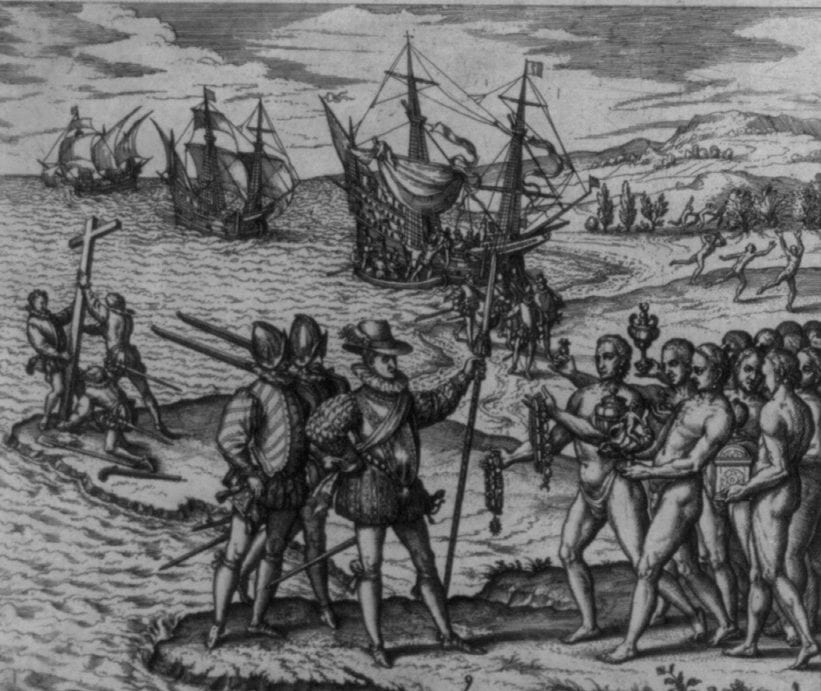
Impressed by the gold, spices, and human captives Columbus brought back from his first expedition, the Spanish crown authorized a quick turnaround for his next voyage with a significantly larger fleet of seventeen ships and 1200 men. Also on the expedition were settlers encouraged by promises of large quantities of gold in the islands. The Spanish crown ordered Columbus to Christianize all the natives he encountered.
Upon his return to Hispaniola, the settlement he founded on his first landing, Columbus discovered it decimated by disease and war with the natives. The new settlers he brought quickly grew discouraged by the exaggerated claims of gold on the island. Columbus decided to return to Spain for supplies, leaving his brother Bartholomew in charge of Hispaniola. His third trip was equally disastrous. The Spaniards on Hispaniola accused Christopher and his brother of maladministration. A new Spanish administrator arrived in September 1499, investigated the allegations, arrested Columbus, and sent him home in chains.
He attempted to salvage his reputation on his fourth voyage by finally locating the sea route to Asia. Ironically, he landed on the coast of Nicaragua and Panama, the area future visionaries saw as the best place to construct a man-made canal from the Atlantic to the Pacific Ocean. The Panama Canal is now the route Columbus hoped nature had provided.
Columbus’s expeditions decimated the native Taino population of the Caribbean. It began an age of exploration that led to the triangular trade of the colonial era, where raw goods produced with enslaved labor were shipped to Europe, where rum and other manufactured goods were produced and traded in Africa for more enslaved African people. Thus, his expeditions are important because they permanently changed the relationship between Europe, Africa, and the Americas.
How should we teach students about Columbus?
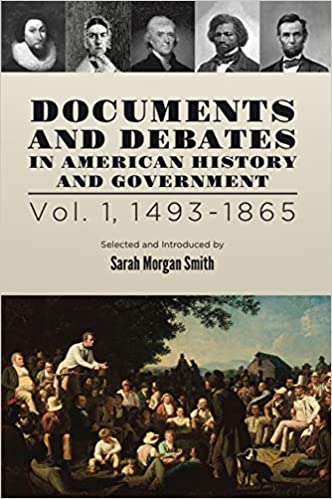
Though I am no longer in the classroom, every time I research a topic for a blog post, I evaluate how I would change my lessons. In the past, when teaching Columbus, I assigned my students an excerpt from historian David E. Stannard’s book, American Holocaust . Stannard’s descriptions of Columbus’s treatment of the indigenous people are horrific. His descriptions of contemporaneous Europe are equally horrible. The students debated whether men from a violent place would treat strangers non-violently.
Here is one way to change that lesson. First, I would divide the students into groups to analyze each of Columbus’s four voyages and ask them to consider the stated goals of each trip, plus what he learned from each expedition. Next, I would assign Documents and Debates: Early Contact from Volume 1 of TAH’s Core Document Collection so that students read and discuss how the treatment of Native Americans was debated in Columbus’s time before exposing them to a historian’s interpretation. Students should learn that the debate over Columbus’s actions and, thus, his legacy began in the 1490s and continues today. They are free to read the primary and secondary sources and reach their conclusions about the man and his times.
Ray Tyler was the 2014 James Madison Fellow for South Carolina and a 2016 graduate of Ashland University’s Masters Program in American History and Government . Ray is a former Teacher Program Manager for TAH and a frequent contributor to our blog.
Gordon Lloyd (1942–2023)
Multi-day seminar examines the failure of reconstruction and rise of jim crow in the south, join your fellow teachers in exploring america’s history..
The Fourth Voyage of Columbus
If any of Columbus's voyages deserves to be made into a movie, this is the one.
On May 11, 1502, four old ships and 140 men under Columbus's command put to sea from the port of Cadiz. Among those in the fleet were Columbus's brother Bartholomew, and Columbus's younger son Fernando, then just thirteen years old. At age fifty-one, Columbus was old, sick, and no longer welcome in his old home base of Hispaniola. But the Admiral felt he had one more voyage left in him.
The nominal purpose of the trip was to find a strait linking the Indies (which Columbus still thought to be part of Asia) with the Indian Ocean. This strait was known to exist, since Marco Polo had traversed it on his way back from China. In effect, Columbus was looking for the Strait of Malacca (which is really near Singapore) in Central America.
Columbus arrived at Santo Domingo on June 29, 1502, and requested that he be allowed to enter the harbor to shelter from a storm that he saw coming. He also advised the treasure fleet assembling in the harbor to stay put until the storm had passed. His request was treated with contempt by Nicolas de Ovando, the local governor, who denied Columbus the port and sent the treasure fleet on its way. Columbus found shelter for his ships in a nearby estuary.
When the hurricane hit, the treasure fleet was caught at sea, and twenty ships were sunk. Nine others limped back into Santo Domingo, and only one made it safely to Spain. Columbus's four ships all survived the storm with moderate damage.
Columbus arrived at the coast of Honduras at the end of July, and spent the next two months working down the coast, beset by more storms and headwinds. When they arrived at present-day Panama, they found two important things. First, they learned from the natives that there was another ocean just a few days march to the south. This convinced Columbus that he was near enough the strait that he had proved his point. But more importantly, the natives had many gold objects that the Spaniards traded for. This made the region, which Columbus named Veragua, very valuable.
After coasting east along Panama until the area rich in gold petered out, Columbus tried to return to Veragua but was again beset by storms and contrary winds. Finally, Columbus returned to the mouth of the Rio Belen (western Panama) on January 9, 1503, and made it his headquarters for exploration, building a garrison fort there. As he was preparing to return to Spain, he took three of his ships out of the river, leaving one with the garrison. The next day, April 6, the river lowered so much that the remaining ship was trapped in the river by a sandbar across the river mouth. At this moment, a large force of Indians attacked the garrison.
The Spanish managed to hold off the attack, but lost a number of men and realized that the garrison could not be held for long. Columbus abandoned the ship in the river, and rescued the remaining members of the garrison. The three ships, now badly leaking from shipworm, sailed for home on April 16.
One of the remaining ships had to be abandoned almost immediately because it was no longer seaworthy, and the remaining two crawled slowly upwind in a game effort to make it to Hispaniola. They didn't make it. Off the coast of Cuba, they were hit by yet another storm, the last of the ship's boats was lost, and one of the caravels was so badly damaged that she had to be taken in tow by the flagship. Both ships were leaking very badly now, and water continued to rise in the hold in spite of constant pumping by the crew. Finally, able to keep them afloat no longer, Columbus beached the sinking ships in St. Anne's Bay, Jamaica, on June 25, 1503. Since there was no Spanish colony on Jamaica, they were marooned.
Diego Mendez, one of Columbus's captains, bought a canoe from a local chief and sailed it to Hispaniola. He was promptly detained by governor Ovando outside the city for the next seven months, and was refused use of a caravel to rescue the expedition.
Meanwhile, half of those left on Jamaica staged a mutiny against Columbus, which he eventually put down. When Ovando finally allowed Mendez into Santo Domingo, there were no ships available for the rescue. Finally, Mendez was able to charter a small caravel, which arrived at Jamaica on June 29, 1504, and rescued the expedition. Columbus returned home to Spain on November 7, 1504, his last voyage complete.
Early Americas Digital Archive
Columbus, letter from the fourth voyage.
An Electronic Edition · Christopher Columbus (1451-1506)
Original Source: The Voyages of Christopher Columbus, Being the Journals of his First and Third, and the Letters Concerning his First and Last Voyages, to Which is Added the Account of his Second Voyage Written by Andres Bernaldez. Now newly Translated and Edited, with an Introduction and Notes, by Cecil Jane. London: The Argonaut Press, 1930.
Copyright 2006. This text is freely available provided the text is distributed with the header information provided.
Full Colophon Information
LETTER OF COLUMBUS DESCRIBING HIS FOURTH VOYAGE
A letter which Don Christopher Columbus, viceroy and admiral of the Indies, wrote to the most Christian and most mighty king and queen of Spain, our sovereigns, in which he notified them of that which had occurred on his voyage, and of the lands, provinces, cities and rivers, and other marvellous things, and where there are mines of gold in great abundance, and other things of great richness and value. .
Most serene and very high and mighty princes, the king and queen, our sovereigns: From Cadiz I passed to the Canaries in four days and thence, in sixteen, to the Indies, whence I wrote that my intention was to hasten my voyage, while I had ships, crews and supplies in good condition, and that my course lay to the island of Jamaica, and I wrote this in the island of Dominica. Until I arrived there, I had most excellent weather. On the night that I came there, a great storm burst, and ever since bad weather has pursued me. .
When I arrived off Española, I sent away a budget of letters, and asked as a favour that I might be supplied with a ship at my own cost, since one which I had with me was unseaworthy and could not carry sail. They took the letters and your highnesses will know if they delivered them to you. So far as I was concerned, the answer was that I was ordered from here not to come or go on shore. The hearts of the people who were with me failed them, for fear that I should take them farther, and they said that were any danger to come upon them, they would not be aided there, but would rather have some great ill done to them. Moreover, any who pleased could say that the commendator would have control of the lands which I might gain. .
The storm was terrible and on that night the ships were parted from me. Each one of them was reduced to an extremity, expecting nothing save death; each one of them was certain that the others were lost. What man has been horn, not excepting Job, who would not have been ready to die of despair? For, in such weather, when it was for my: safety and for that of my son, my brother, and my friends, I was forbidden the land and harbours which, by the will of God, I, sweating blood, gained for Spain. .
I return to the ships, which the storm had so carried away from me as to leave me alone. Our Lord restored them to me, when it pleased Him. The unseaworthy vessel had put out to sea in order to escape; near the island the Gallega lost her boat, and all lost a great part of their provisions; that in which I was, although amazingly tossed about, our Lord saved, so that she suffered no damage at all. My brother was in the unseaworthy vessel, and he, after God, was her salvation. .
With this storm I made my way painfully to Jamaica. There the sea changed from rough to calm, and there was a strong current which carried me as far as the Jardin de la Reina, without land being sighted. Thence, when I was able, I steered for Tierra Firme. On the way the wind and a terrible current were against me; I struggled with them for sixty days and in the end had not been able to make more than seventy leagues. During all this time, I did not put into harbour, nor could I, nor did the storm from heaven cease; there was rain and thunder and lightning continuously, so that it seemed as if it were the end of the world. .
I reached cape Gracias a Dios, and from that point our Lord gave me a favouring wind and current. This was on the twelfth of September. Eighty—eight days had there been during which the awe—inspiring tempest did not cease, so that for so long I saw neither sun nor stars for the sea. My ships were stripped, and anchors, rigging and cables were lost, with the boats and many stores; the crews were weak and all were contrite and many turned to religion, nor was there one who did not make vows and promise pilgrimages. Many times they came to the point of confessing one another. Other storms have been seen, but none has ever endured so long or been so terrible. .
Many whom we regarded as men of courage were in a state of great terror and that many times. The distress of my son, whom I had there, racked my soul, and the more since I saw him, at the tender age of thirteen years, so exhausted and for so long a time. Our Lord gave him such courage that he revived the spirit of the others, and he acted as if he had been a sailor for eighty years and he consoled me. I had fallen ill and had many times come to the point of death. From a little shelter, which I ordered to be fixed up on deck, I directed the course. .
My brother was in the worst ship and that which was in the greatest danger. My grief was great, and was the greater because I had brought him with me against his will. Speaking of myself, little profit had I won from twenty years of service, during which I have served with so great labours and perils, for today I have no roof over my head in Castile; if I wish to sleep or eat, I have no place to which to go, save an inn or tavern, and most often I lack the wherewithal to pay the score. .
Another sorrow tore my very heartstrings, and that was for Diego, my son, whom I had left in Spain an orphan and dispossessed of my honour and estate. Yet I was assured that there, as just and grateful princes, you would make restitution to him of all, with increase. .
I reached the land of Cariay, where I halted to repair the ships and to replenish the stores, and to give relaxation to the people who were very weak. There I, who, as I have said, had many times come to the point of death, heard of the mines of gold of the provinces of Ciamba, which I was seeking. Two Indians brought me to Carambaru, where the people go naked and have a golden mirror hanging at the neck, but are unwilling to sell it or to give it in exchange. .
They named to me many places on the seacoast, where they said that there was gold and mines; the last was Veragua, distant from there a matter of twenty—five leagues. I departed with the intention of examining these places fully, and having gone half—way, I learned that there were mines at two days’ journey. I decided to send to visit them. The eve of SS. Simon and Jude was fixed for our departure; on that night there arose so great a sea and wind that it was necessary to run before it where it drove us; and the Indian who was the guide to the mines was always with me. .
In all these places where I have been, I found all that I had heard to be true. This convinced me that it is so in the case of the province of Ciguare, which, according to them, lies inland to the west nine days’ journey. They say that there is in that land an infinite amount of gold, and that the people wear corals on their heads and very large bracelets of coral on their feet and arms; and that with coral they adorn and inlay chairs and chests and tables. They said also that the women there have necklaces hanging down from the head to the shoulders. All the people of these places agree in this that I have related, and they say so much that I should be content with the tenth of it. They also know of pepper. .
In Ciguare they are accustomed to trade in fairs and markets; so these people related, and they showed me the way and manner in which they carry on barter. Further they said that the ships carry cannon, bows and arrows, swords and shields, and that the people go clothed, and that in the land there are horses, and that the people are warlike and wear rich clothing and have good houses. Also they say that the sea surrounds Ciguare, and that from there it is ten days’ journey to the river Ganges. It appears that these lands lie in respect of Veragua as Tortosa does in respect of Fuenterabia; or Pisa in respect of Venice. When I left Carambaru and arrived at these places which I have mentioned, I found the same customs among the people, except that any, who had the mirrors of gold, bartered them at the rate of one for three hawks’ bells, although they were ten or fifteen ducats in weight. In all their customs they are as those of Española. They collect gold by different methods, although these are all nothing in comparison with those of the Christians. .
This which I have said is that which I have heard. That which I know is that in the year ninety—four I navigated twenty—four degrees to the westward in nine hours, and I cannot be in error because there was an eclipse; the sun was in Libra and the moon in Aries. That also which I heard by word of mouth, I knew in detail from the written word. .
Ptolemy believed that he had well corrected Marinus, who is now found to have been very near the truth. Ptolemy places Catigara twelve lines from his west, which he fixed at two and one third degrees above Cape St. Vincent in Portugal. Marinus comprised the earth and its limits in fifteen lines. In Ethiopia Marinus draws beyond the equinoctial lines more than twenty—four degrees, and now that the Portuguese have sailed there, they find that this is true. Ptolemy says that the most southern land is the first place and that it does not lie more than fifteen and one—third degrees beyond. And the world is small. The dry land is six parts of it; the seventh only is covered with water. Experience has already shown this, and I have written it in other letters and with illustration from Holy Scripture concerning the situation of the earthly paradise, as Holy Church approves. I say that the world is not so great as the vulgar believe, and that a degree from the equinoctial line is fifty—six and two—thirds miles; easily this may be proved exactly. I leave this subject, inasmuch as it is not my intention to speak of this matter, but only to give an account of my voyage, hard and toilsome, although it is the most noble and profitable. .
I have said that on the eve of SS. Simon and Jude I ran where the wind bore me, without being able to resist it. In a harbour I sheltered for ten days from the great violence of sea and wind; there I decided not to go back to the mines and I left them as gained already. I departed, to continue my voyage, in rain. I reached the harbour of Bastimentos, where I entered and not of my free will; the storm and a great current kept me in it for fourteen days. And afterwards I departed and that not with fair weather. When I had gone fifteen leagues with difficulty, the wind and current with fury drove me back. Returning to the harbour whence I had set out, I found on the way el Retrete, where I put in with great danger and distress, and being myself, and the ships and the people, very worn out. There I stayed for fifteen days, compelled to do so by the cruel weather, and when I believed that it was ended, I found that it was beginning. There I changed my intention of going to the mines and of doing anything until the weather should be favourable for my voyage and for putting to sea. When I had gone four leagues, the storm returned and so wearied me that I knew not what to do. There my wound reopened. For nine days I was lost, without hope of life; eyes never saw the sea so high, so rough, so covered with foam. The wind did not allow us to go forward, nor did it permit us to run under any headland. There was I held, in a sea turned to blood, boiling as a cauldron on a mighty fire. Never did the heavens appear more terrible. For a day and a night they blazed like a furnace, and the lightning darted forth in such flashes that I wondered every moment whether it had destroyed my masts and sails; the flashes came with such terrifying fury that we all believed that the ships must be consumed. All this while the water from heaven never ceased, and it cannot be said that it rained, but rather that there was a second universal deluge. The crews were already so broken in spirit that they longed for death as a release from such martyrdom. The ships had already twice lost their boats, anchors, and rigging, and were stripped bare, without sails. .
When it pleased our Lord, I returned to Puerto Gordo, where I repaired things as well as I could. Once more I turned back towards Veragua; for my voyage, although I was set upon it, the winds and currents were still contrary. I arrived almost where I had been before, and there again the wind and currents opposed me, and once more I put into port, since I did not dare to await the opposition of Saturn with Mars, so tossed about on a dangerous coast, since that generally brings storms or heavy weather. This was on the day of the Nativity, at the hour of mass. I came again to the point whence I had so laboriously set forth, and when the new year had come in, I resumed my struggling. But even if I had found good weather for my voyage, the ships were unseaworthy, and the crews dead or sick. .
On the day of the Epiphany I reached Veragua, being now without spirit. There our Lord gave me a river and a safe harbour, although at the entrance there were only ten spans of water. I made an entry with difficulty, and on the following day the storm began again; if it had found me outside, I should not have been able to enter, on account of the bar. It rained without ceasing until the fourteenth of February, so that there was no opportunity to penetrate into the interior or to repair my situation in any way. And on the twentyfourth of January, when I was already safely within, suddenly the river rose to a great height and violence. The cables were broken and the post to which they were fastened, and it almost bore away my ships, and certainly I saw them in greater danger than ever. Our Lord gave me a remedy, as He has always done. I do not know of any one who has suffered greater martyrdom. .
On the sixth of February, while the rain continued, I sent seventy men ashore into the interior. At five leagues’ distance, they found many mines. The Indians, who went with them, led them to a very lofty hill and from it showed them the country all round as far as the eye could reach, saying that there was gold everywhere and that towards the west the mines extended for twenty days’ journey, and they named the towns and villages, saying where there were more or less of them. Afterwards I learned that the Quibian who had given these Indians, had commanded them to show distant mines which belonged to one who was his enemy, and that within his own territory a man might collect in ten days as much gold as a child could carry, whenever he wished. I bear with me the Indians, his servants, and witnesses to this. .
The boats went to the place where he had his village. My brother returned with these people, and all came back with the gold that they had collected in the four hours for which they stayed there. The quantity is great, for none of these men had ever seen mines and most of them had never seen gold; the majority of them were sailors and most of them grumets. I had much building material and stores in abundance. I formed a settlement and I gave many gifts to the Quibian, as they call the lord of the country. And I knew that harmony would not long continue; they were very barbarous and our people were very importunate, and I had assumed possession within his territory. When he saw the houses built and trading so active, he decided to burn the buildings and to put all to death. But his scheme had just the contrary result. He was taken prisoner, with his women, sons and servants. It is true that his captivity did not last long; the Quibian escaped from a trustworthy man who had him under his charge with a guard of men, and his sons escaped from the master of a ship, into whose special care they had been given. .
In the month of January, the mouth of the river silted up. In April, the ships were all wormeaten, and it was impossible to keep them above water. At this time, the river made a channel, by which with difficulty I brought out three empty. The boats went back into the river for salt and water. The sea became high and rough and did not allow them to come out. The Indians were many and gathered together and attacked them, and in the end they slew them. My brother and all the rest of the people were in a ship which remained inside. I was outside on so dangerous a coast, utterly alone, in a high fever and in a state of great exhaustion. Hope of escape was dead. I toiled up to the highest point of the ship, calling in a trembling voice, with fast falling tears, to the war captains of your highnesses, at every point of the compass, for succour, but never did they answer me. Exhausted, I fell asleep, groaning. I heard a very compassionate voice, saying: “O fool and slow to believe and to serve thy God, the God of all! What more did He for Moses or for His servant David? Since thou wast born, ever has He had thee in His most watchful care. When He saw thee of an age with which He was content, He caused thy name to sound marvellously in the land. The Indies, which are so rich a part of the world, He gave thee for thine own; thou hast divided them as it pleased thee, and He enabled thee to do this. Of the barriers of the Ocean sea, which were closed with such mighty chains, He gave thee the keys; and thou wast obeyed in many lands and among the Christians thou hast gained honourable fame. What did He more for the people of Israel when He brought them out of Egypt? Or for David, whom from a shepherd He made to be king in Judea? Turn thyself to Him, and know now thine error; His mercy is infinite; thine old age shall prevent thee from achieving all great things; He has many heritages very great. Abraham had passed a hundred years when he begat Isaac, and was Sarah young? Thou criest for help, doubting. Answer, who has afflicted thee so greatly and so often, God or the world? The rewards and promises which He gives, He does not bring to nothing, nor does He say, after He has received service, that His intention was not such and that it is to be differently regarded, nor does He inflict suffering in order to display His power. His deeds agree with His words; all that He promises, He performs with interest; is this the manner of men? I have said that which thy Creator has done for thee and does for all men. Now in part He shows thee the reward for the anguish and danger which thou hast endured in the service of others.” .
I heard all this as if I were in a trance, but I had no answer to give to words so true, but could only weep for my errors. He, whoever he was, who spoke to me, ended saying: “Fear not; have trust; all these tribulations are written upon marble and are not without cause.” .
I arose when I was able, and at the end of nine days came fine weather, but not such as allowed the ships to be brought out of the river. I gathered together the people who were on land, and all the rest that I could, because they were not sufficiently numerous for some to remain on shore and others to navigate the ships. I would have remained with all of them to maintain the settlement, if your highnesses had known of it. The fear that ships might never come there determined me, and the consideration that, when there was a question of providing succour, provision might be made for all. .
I departed in the name of the Holy Trinity on Easter night, with ships rotten, worm—eaten, all full of holes. There in Belen I left one and many things; in Belpuerto I did the same with another. There remained for me two only, in the condition of the others, and without boats and stores, with which to traverse seven thousand miles of sea and waves, or to die on the way with my son and brother and so many people. Let those, who are accustomed to find fault and to censure, asking there, where they are in safety, “Why was not soand-so done in that case?”, make answer now. I could wish them on this voyage; I verily believe that another voyage of another kind is in store for them, or our Faith is vain. .
On the thirteenth of May, I reached the province of Mago, which marches with that of Catayo, and thence I departed for Española. For two days I navigated with good weather, and after that it was unfavourable. I followed a route which would avoid the very numerous islands, in order that I might not be in difficulties in the shallows near them. The stormy sea assailed me, and I was driven backwards without sails. I anchored at an island where I suddenly lost three anchors, and at midnight, when it seemed that the world was dissolving, the cables of the other ship broke and it bore down on me, so that it was a wonder that we were not dashed to pieces. The anchor, such as remained to me, was that which, after our Lord, saved me. .
At the end of six days, when fair weather came, having thus already lost all my tackle, I proceeded on my voyage. My ships were more riddled with holes than a honeycomb, and the crews were spiritless and despairing. I passed somewhat beyond the point at which I had previously arrived, where the storm had driven me back, and I put into a much safer harbour in the same island. .
At the end of eight days I resumed my voyage and at the end of June reached Jamaica, having always contrary winds and the ships in a worse state. With three pumps, pots and kettles, and with all hands working, they could not keep down the water which came into the ship, and there was no other remedy for the havoc which the worm had wrought. I steered a course which should bring me as near as possible to the coast of Española, from which we were twenty—eight leagues distant, and I wished that I had not begun to do so. The other ship, half under water, was obliged to run for port. I struggled to keep the sea against the storm. My ship was sinking under me, when our Lord miraculously brought me to land. Who will believe that which I write here? I declare that in this letter I have not told the hundredth part. Those who were with the admiral can testify to this. .
If it please your highnesses graciously to accord me the help of a ship of above sixtyfour tons, with two hundred quintals of biscuit and some other provision, that would suffice to bring me and these people to Spain from Española. I have already said that it is only twenty—eight leagues from Jamaica to Española. I would not have gone to Española, even if the ships had been fit to do so; I have already said that orders were given me on behalf of your highnesses that I should not come there. If this command has profited, God knows. This letter I send by means and by the hand of Indians; it will be a great wonder if it reach its destination. .
I say this of my voyage, that there were with me a hundred and fifty persons, among whom there were some very capable pilots and great sailors. No one of them can give any certain account of where I went or where I came. The reason is not far to seek. I set out from a point above Puerto del Brasil; off Española, the storm prevented me from following the course which I desired; owing to its violence I had to run where the wind drove me. At that time, I fell very sick; no one had navigated in that direction. Then the wind and sea abated for some days, and in place of the storm there were calms and strong currents. I put into harbour at an island which is called de las Pozas, and thence steered for Tierra Firme. None can give a true account of this, for there was no sufficient reason, for I was obliged to go with the current, without seeing land, for so very many days. I followed the coast of Tierra Firme; this I ascertained by the compass and my skill. There was no one who could say under what part of the heavens we were, and when I set out thence to come to Española, the pilots believed that we were going to reach the island of San Juan, and it was the land of Mango, four hundred leagues more to the west than they said. Let them answer, if they know how, where Veragua is situated. I declare that they can give no other explanation or account, save that they went to lands where there is much gold, and this they are able to certify. But to return to it, they would have to follow an unknown route; it would be necessary for them to go to discover it as if for the first time. There is a method and means derived from astrology and certain, which is enough for one who understands it. This resembles a prophetic vision. .
In the Indies, if ships do not sail except with the wind abaft, it is not because they are ill built or because they are clumsy. The strong currents that are there, together with the wind, bring it about that hone can sail with the bowline, for in one day they would lose as much way as they might have made in seven, nor does a caravel serve, even if it be a Portuguese lateen—rigged vessel. This is the reason why they do not sail except with a regular breeze, and they sometimes remain in harbour waiting for it for seven or eight months, nor is this strange, since the same thing often occurs in Spain. .
The people of whom Pope Pius II writes, the country and its characteristics, have been found, but not the horses with saddles, poitrels and bridles of gold. Nor is this strange, for there the coast lands require only fisherfolk, nor did I stay there, since I went in haste. In Cariay and in these lands near, there are great enchanters and very awe—inspiring. They would have given the world that I should not have been remained there an hour. When I arrived there, they sent to me at once two girls, very showily dressed; the elder was not more than eleven years old and the other seven; they were both so abandoned that they were not better than prostitutes. They carried magic powder concealed about them. When they came, I commanded that they should be decorated with some of our things and sent them back to land at once. .
There on the mountain I saw a tomb, as large as a house and carved, and the corpse was lying in it exposed and embalmed. They told me of other works of art and very excellent. There are many animals, small and large, and very different from ours. I had at the time two hogs, and an Irish dog did not dare to face them. A crossbowman had wounded an animal, which appeared to be an ape, except that it was much larger and had the face of a man. The arrow had pierced it from the neck to the tail, and as a result it was so fierce that it was necessary to cut off an arm and a leg. When the hog saw it, it bristled up and fled. When I saw this, I ordered the begare, as it is called there, to be thrown where the hog was; coming within reach, although it was on the point of death and although the arrow was still in its body, it twisted its tail round the hog’s snout and holding it very firmly, seized it by the nape of the neck and with its remaining hand struck it on the head, as if it were an enemy. This action was so novel and such a delightful sight that I have described it. They have many kinds of animals, but they all die of barra. I saw many very large fowls and with feathers like wool; lions, stags; besides fallow, deer, and also birds. .
While I wearily traversed that sea, a delusion came to some that we were bewitched and they still persist in that idea. I found another people who eat men; their brutal appearance showed this. They say that there are great mines of copper; of it they make hatchets, other worked articles, cast and soldered, and forges with all the tools of a goldsmith, and crucibles. There they go clothed. And in this province I saw large cotton sheets, very cleverly worked; others were very cleverly painted in colours with pencils. They say that in the country inland towards Catayo, they have them worked with gold. Of all these lands and of that which there is in them, owing to lack of interpreter, they could not learn very much. The villages, although they are very close together, have each a different language, and it is so much so that they do not understand one another any more than we understand the Arabs. I believe that this is the case with the uncivilised people of the coast, but not inland. .
When I discovered the Indies, I said that they were the richest dominion that there is in the world. I was speaking of the gold, pearls, precious stones and spices, with the trade and markets in them, and because everything did not appear immediately, I was held up to abuse. This punishment leads me now to say only that which I have heard from the natives of the land. Of one thing I dare to speak, because there are so many witnesses, and this is that in this land of Veragua I saw greater evidence of gold on the first two days than in Española in four years, and that the lands in this district could not be more lovely or better cultivated, nor could the people be more timid, and there is a good harbour and a beautiful river and it is defensible against the world. All this makes for the security of the Christians and the assurance of their dominion, and gives great hope for the honour and increase of the Christian religion. And the voyage thither will be as short as to Española, since it will be with the wind. Your highnesses are as much sovereigns of this land as at Jerez or Toledo; your ships may go there as if they were going home. Thence they will obtain gold; in other lands, in order to become masters of that which is in them, it requires that they should seize it or return empty, and inland it is necessary for them to trust their persons to a savage. .
Concerning the rest, of which I refrain from speaking, I have said, why I put a guard on myself. Accordingly, I do not mention the sixth part in all that I have ever said and written, nor do I assert it as true, nor do I declare that I am at the fountain head. Genoese, Venetians and all who have pearls, precious stones and other things of value, all carry them to the end of the world in order to exchange them, to turn them into gold. Gold is most excellent. Gold constitutes treasure, and he who possesses it may do what he will in the world, and may so attain as to bring souls to Paradise. When the lords of those lands which are in the district of Veragua die, they bury the gold which they have with the body; so they say. .
To Solomon on one journey they brought six hundred and sixty—six quintals of gold, besides that which the merchants and sailors brought, and besides that which was paid in Arabia. From this gold, he made two hundred lances and three hundred shields, and he made the covering that was above them of massive gold and adorned with precious stones. Josephus writes this in his chronicle of the Antiquities; in the book of Chronicles, and in the book of Kings, there is an account of this. Josephus holds that this gold was obtained in the Aurea. If it were so, I declare that those mines of the Aurea are one and the same as these of Veragua, which, as I have said above, extend westward twenty days’ journey, and are at the same distance from the Pole as from the Equator. Solomon bought all that gold, precious stones, and silver, and you may command it to be collected there, if you wish. David, in his will, left three thousand quintals of gold of the Indies to Solomon to aid in building the Temple, and, according to Josephus, it was from these same lands. .
Jerusalem and Mount Sion are to be rebuilt by the hand of a Christian; who this is to be, God declares by the mouth of his prophet in the fourteenth Psalm. Abbot Joachin said that he was to come from Spain. St. Jerome showed the way to it to the holy lady. The emperor of Catayo, some time since, sent for wise men to instruct him in the faith of Christ. Who will offer himself for this work? If our Lord bring me back to Spain, I pledge myself, in the name of God, to bring him there in safety. .
The people who came with me have suffered incredible toils and dangers. I pray your highnesses, since they are poor, that you will command that they be paid immediately, and that you will grant rewards to each one of them according to their quality, for I certify that to my belief they bear the best news that ever there came to Spain. .
Although the gold which the Quibian has in Veragua and which others in that neighbourhood have, is, according to accounts, very abundant, it does not appear to me to be well or for the service of your highnesses that it should be seized violently. Fair dealing will avoid scandal and ill report, and it will be that all will come to the treasury, so that not a grain is left. .
With a month of fair weather, I shall complete all my voyage. I did not persist in delaying to enter on it, because there was a lack of ships, and for all that concerns your service, I hope in Him Who made me, that I shall be of use. I believe that your highness will remember that I wished to order the construction of ships in a new manner; the brevity of the time did not give room for this, and I foresaw certainly that which has come to pass. I hold that in this trade and mines of such extent and such dominion there is more than there is in all else that has been done in the Indies. This is not a child to be left to the care of a stepmother. .
Of Española, Paria, and the other lands, I never think without weeping. I believed that their example would have been to the profit of others; on the contrary, they are in a languid state although they are not dead; the infirmity is incurable or very extensive; let him who brought them to this state come now with the remedy if he can or if he knows it; in destruction, everyone is an adept. It was always the custom to give thanks and promotion to him who imperilled his person. It is not just that he who has been so hostile to this undertaking should enjoy its fruits or that his children should. Those who left the Indies, flying from toils and speaking evil of the matter and of me, have returned with official employment. So it has now been ordained in the case of Veragua. It is an ill example and without profit for the business and for the justice in the world. .
The fear of this, with other sufficient reasons, which I saw clearly, led me to pray your highnesses before I went to discover these islands and Tierra Firme, that you would leave them to me to govern in your royal name. It pleased you; it was a privilege and agreement, and under seal and oath, and you granted me the title of viceroy and admiral and governor—general of all. And you fixed the boundary, a hundred leagues beyond the Azores and the Cape Verde Islands, by a line passing from pole to pole, and you gave me wide power over this and over all that I might further discover. The document states this very fully. .
The other most important matter, which calls aloud for redress, remains inexplicable to this moment. Seven years I was at your royal court, where all to whom this undertaking was mentioned, unanimously declared it to be a delusion. Now all, down to the very tailors, seek permission to make discoveries. It can be believed that they go forth to plunder, and it is granted to them to do so, so that they greatly prejudice my honour and do very great damage to the enterprise. It is well to give to God that which is His due and to Caesar that which belongs to him. This is a just sentiment and based on justice. .
The lands which here obey your highnesses are more extensive and richer than all other Christian lands. After that I, by the divine will, had placed them under your royal and exalted lordship, and was on the point of securing a very great revenue, suddenly, while I was waiting for ships that I might come to your high presence with victory and with great news of gold, being very secure and joyful, I was made a prisoner and with my two brothers was thrown into a ship, laden with fetters, stripped to the skin, very ill—treated, and without being tried or condemned. Who will believe that a poor foreigner could in such a place rise against your highnesses, without cause, and without the support of some other prince, and being alone among your vassals and natural subjects, and having all my children at your royal court? .
I came to serve at the age of twenty—eight years, and now I have not a hair on my body that is not grey, and my body is infirm, and whatever remained to me from those years of service has been spent and taken away from me and sold, and from my brothers, down to my very coat, without my being heard or seen, to my great dishonour. It must be believed that this was not done by your royal command. The restitution of my honour, the reparation of my losses, and the punishment of him who did this, will spread abroad the fame of your royal nobility. The same punishment is due to him who robbed me of the pearls, and to him who infringed my rights as admiral. Very great will be your merit, fame without parallel will be yours, if you do this, and there will remain in Spain a glorious memory of your highnesses, as grateful and just princes. .
The pure devotion which I have ever borne to the service of your highnesses, and the unmerited wrong that I have suffered, will not permit me to remain silent, although I would fain do so; I pray your highnesses to pardon me. I am so ruined as I have said; hitherto I have wept for others; now, Heaven have mercy upon me, and may the earth weep for me. Of worldly goods, I have not even a blanca for an offering in spiritual things. Here in the Indies I have become careless of the prescribed forms of religion. Alone in my trouble, sick, in daily expectation of death, and encompassed about by a million savages, full of cruelty, and our foes, and so separated from the Blessed Sacraments of Holy Church, my soul will be forgotten if it here leaves my body. Weep for me, whoever has charity, truth and justice. .
I did not sail upon this voyage to gain honour or wealth; this is certain, for already all hope of that was dead. I came to your highnesses with true devotion and with ready zeal, and I do not lie. I humbly pray your highnesses that if it please God to bring me forth from this place, that you will be pleased to permit me to go to Rome and to other places of pilgrimage. May the Holy Trinity preserve your life and high estate, and grant you increase of prosperity. .
Done in the Indies, in the island of Jamaica, on the seventh of July, in the year one thousand five hundred and three. .
The original document of Columbus of this document was written in 1502 .
This text of the present edition was prepared from and proofed against The Voyages of Christopher Columbus, Being the Journals of his First and Third, and the Letters Concerning his First and Last Voyages, to Which is Added the Account of his Second Voyage Written by Andres Bernaldez. Now newly Translated and Edited, with an Introduction and Notes, by Cecil Jane. London: The Argonaut Press, 1930. For the present edition, all preliminaries and notes have been omitted except those for which the author is responsible. All editorial notes have been omitted except those that indicate significant textual variations. Line and paragraph numbers contained in the source text have been retained. In cases where the source text displays no numbers, numbers are automatically generated. In the header, personal names have been regularized according to the Library of Congress authority files as "Last Name, First Name" for the REG attribute and "First Name Last Name" for the element value. Names have not been regularized in the body of the text.
One thought on “Columbus, Letter from the Fourth Voyage”
- Pingback: Happy Columbus Day Folks! | Hyrum Laney
The Third Voyage of Christopher Columbus
Artem Dunaev / EyeEm / Getty Images
- History Before Columbus
- Colonialism and Imperialism
- Caribbean History
- Central American History
- South American History
- Mexican History
- American History
- African American History
- African History
- Ancient History and Culture
- Asian History
- European History
- Medieval & Renaissance History
- Military History
- The 20th Century
- Women's History
- Ph.D., Spanish, Ohio State University
- M.A., Spanish, University of Montana
- B.A., Spanish, Penn State University
After his famous 1492 voyage of discovery , Christopher Columbus was commissioned to return a second time, which he did with a large-scale colonization effort which departed from Spain in 1493. Although the second journey had many problems, it was considered successful because a settlement was founded: it would eventually become Santo Domingo , capital of the present-day Dominican Republic. Columbus served as governor during his stay in the islands. The settlement needed supplies, however, so Columbus returned to Spain in 1496.
Preparations for the Third Voyage
Columbus reported to the crown upon his return from the New World. He was dismayed to learn that his patrons, Ferdinand and Isabella , would not allow enslaved people from the newly discovered lands to be used as payment. As he had found little gold or precious commodities for which to trade, he had been counting on selling enslaved people to make his voyages lucrative. The King and Queen of Spain allowed Columbus to organize a third trip to the New World with the goal of resupplying the colonists and continuing the search for a new trade route to the Orient.
The Fleet Splits
Upon departure from Spain in May of 1498, Columbus split his fleet of six ships: three would make for Hispaniola immediately to bring desperately needed supplies, while the other three would aim for points south of the already explored Caribbean to search for more land and perhaps even the route to the Orient that Columbus still believed to be there. Columbus himself captained the latter ships, being at heart an explorer and not a governor.
Doldrums and Trinidad
Columbus’ bad luck on the third voyage began almost immediately. After making slow progress from Spain, his fleet hit the doldrums, which is a calm, hot stretch of ocean with little or no wind. Columbus and his men spent several days battling heat and thirst with no wind to propel their ships. After a while, the wind returned and they were able to continue. Columbus veered to the north, because the ships were low on water and he wanted to resupply in the familiar Caribbean. On July 31, they sighted an island, which Columbus named Trinidad. They were able to resupply there and continue exploring.
Sighting South America
For the first two weeks of August 1498, Columbus and his small fleet explored the Gulf of Paria, which separates Trinidad from mainland South America. In the process of this exploration, they discovered the Island of Margarita as well as several smaller islands. They also discovered the mouth of the Orinoco River. Such a mighty freshwater river could only be found on a continent, not an island, and the increasingly religious Columbus concluded that he had found the site of the Garden of Eden. Columbus fell ill around this time and ordered the fleet to head to Hispaniola, which they reached on August 19.
Back in Hispaniola
In the roughly two years since Columbus had been gone, the settlement on Hispaniola had seen some rough times. Supplies and tempers were short and the vast wealth that Columbus had promised settlers while arranging the second voyage had failed to appear. Columbus had been a poor governor during his brief tenure (1494–1496) and the colonists were not happy to see him. The settlers complained bitterly, and Columbus had to hang a few of them in order to stabilize the situation. Realizing that he needed help governing the unruly and hungry settlers, Columbus sent to Spain for assistance. It was also here where Antonio de Montesinos is remembered to have given an impassioned and impactful sermon.

Francisco de Bobadilla
Responding to rumors of strife and poor governance on the part of Columbus and his brothers, the Spanish crown sent Francisco de Bobadilla to Hispaniola in 1500. Bobadilla was a nobleman and a knight of the Calatrava order, and he was given broad powers by the Spanish crown, superseding those of Colombus. The crown needed to rein in the unpredictable Colombus and his brothers, who in addition to being tyrannical governors were also suspected of improperly gathering wealth. In 2005, a document was found in the Spanish archives: it contains first-hand accounts of the abuses of Columbus and his brothers.
Columbus Imprisoned
Bobadilla arrived in August 1500, with 500 men and a handful of native people that Columbus had brought to Spain on a previous voyage to enslave; they were to be freed by royal decree. Bobadilla found the situation as bad as he had heard. Columbus and Bobadilla clashed: because there was little love for Columbus among the settlers, Bobadilla was able to clap him and his brothers in chains and throw them in a dungeon. In October 1500, the three Columbus brothers were sent back to Spain, still in shackles. From getting stuck in the doldrums to being shipped back to Spain as a prisoner, Columbus’ Third Voyage was a fiasco.
Aftermath and Importance
Back in Spain, Columbus was able to talk his way out of trouble: he and his brothers were freed after spending only a few weeks in prison.
After the first voyage, Columbus had been granted a series of important titles and concessions. He was appointed Governor and Viceroy of the newly discovered lands and was given the title of Admiral, which would pass to his heirs. By 1500, the Spanish crown was beginning to regret this decision, as Columbus had proven to be a very poor governor and the lands he had discovered had the potential to be extremely lucrative. If the terms of his original contract were honored, the Columbus family would eventually siphon off a great deal of wealth from the crown.
Although he was freed from prison and most of his lands and wealth were restored, this incident gave the crown the excuse they needed to strip Columbus of some of the costly concessions that they had originally agreed to. Gone were the positions of Governor and Viceroy and the profits were reduced as well. Columbus’ children later fought for the privileges conceded to Columbus with mixed success, and legal wrangling between the Spanish crown and the Columbus family over these rights would continue for some time. Columbus’ son Diego would eventually serve for a time as Governor of Hispaniola due to the terms of these agreements.
The disaster that was the third voyage essentially brought to a close the Columbus Era in the New World. While other explorers, such as Amerigo Vespucci , believed that Columbus had found previously unknown lands, he stubbornly held to the claim that he had found the eastern edge of Asia and that he would soon find the markets of India, China, and Japan. Although many at court believed Columbus to be mad, he was able to put together a fourth voyage , which if anything was a bigger disaster than the third one.
The fall of Columbus and his family in the New World created a power vacuum, and the King and Queen of Spain quickly filled it with Nicolás de Ovando, a Spanish nobleman who was appointed governor. Ovando was a cruel but effective governor who ruthlessly wiped out native settlements and continued the exploration of the New World, setting the stage for the Age of Conquest.
Herring, Hubert. A History of Latin America From the Beginnings to the Present. . New York: Alfred A. Knopf, 1962
Thomas, Hugh. Rivers of Gold: The Rise of the Spanish Empire, from Columbus to Magellan. New York: Random House, 2005.
- Biography of Christopher Columbus
- The Second Voyage of Christopher Columbus
- Biography of Christopher Columbus, Italian Explorer
- 10 Facts About Christopher Columbus
- The Fourth Voyage of Christopher Columbus
- The First New World Voyage of Christopher Columbus (1492)
- The Truth About Christopher Columbus
- Biography of Juan Ponce de León, Conquistador
- La Navidad: First European Settlement in the Americas
- Where Are the Remains of Christopher Columbus?
- Biography of Bartolomé de Las Casas, Spanish Colonist
- Biography of Vasco Núñez de Balboa, Conquistador and Explorer
- Biography of Hernando Cortez
- The History of Santo Domingo, Dominican Republic
- Explorers and Discoverers
- Biography of Diego Velazquez de Cuellar, Conquistador
Skip to Main Content of WWII
Horror in the arctic: the catastrophe of convoy pq-17.
Winston Churchill called it "one of the most melancholy naval episodes in the whole of the war.”
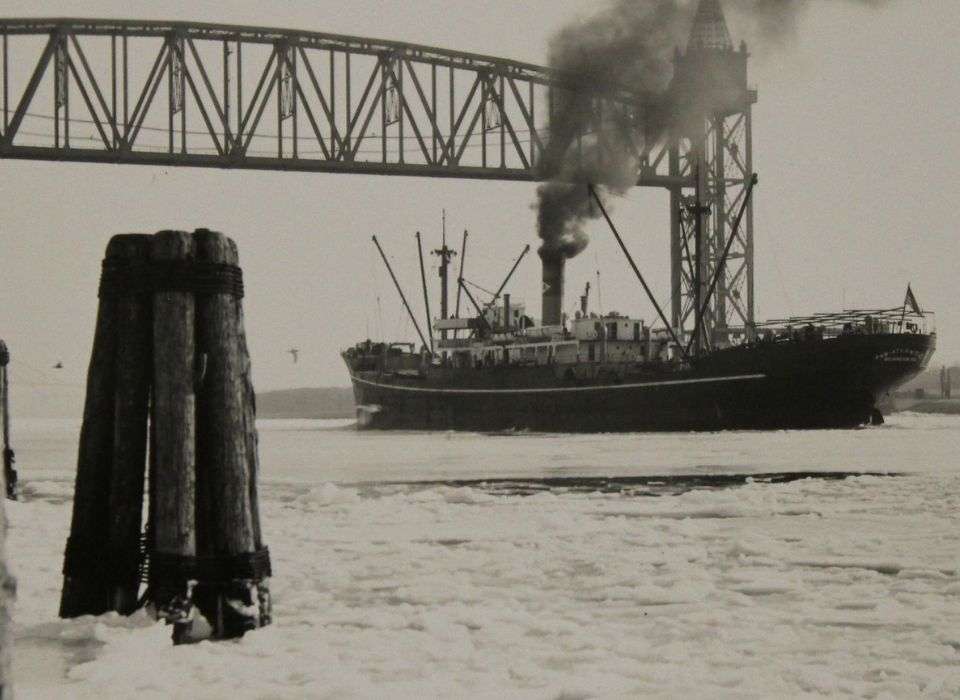
2136 Hours: Most Immediate. My 2123 of the 4th. Convoy is to scatter. – British Admiralty to commanders of Convoy PQ-17, July 4, 1942.
With just these few words, the fate of the Soviet Union bound Convoy PQ-17 was sealed and the story of Seaman Second Class Donald Ross Naggatz (Berg) begins. Naggatz was born in Hastings, Nebraska, but was raised in North Dakota. After the Japanese attack on Pearl Harbor in December 1941, Naggatz enlisted in the US Navy in January 1942. He soon found himself in the Naval Armed Guard which was responsible for manning weapons on US Merchant Marine vessels transporting men and matériel across the world. Naggatz completed his training and headed for duty on the SS Pan Atlantic and Convoy PQ-17.
Merchant ships leaving the United States bound for Europe were taken across the Atlantic in what was known as the convoy system. Groups of ships were gathered from ports across the country and brought together under protection from Allied naval vessels to make the treacherous journey across U-boat-infested waters to the United Kingdom. These convoys had specific code names to track where they were going and coming from. For example, convoys sailing for the Soviet Union were titled PQ and those leaving the Soviet Union QP.
Convoys supplying the Soviet Union began in August 1941 with PQ-1 and initially saw little German opposition to these Arctic shipments. However, by PQ-16 in May 1942, German resistance had dramatically increased. Out of a total of 30 ships in the convoy, the Germans sank or damaged nine, the largest PQ convoy losses to date. When Convoy PQ-17, along with Naggatz and the Pan Atlantic , sailed from Iceland on June 27, 1942, headed for the Soviet port of Arkhangelsk, they faced stiffening German air and naval defenses, brutal Arctic temperatures, and around-the-clock daylight which meant no protection from the cover of darkness. The Arctic route known as “The Murmansk Run” was about to turn deadly for the men and ships of PQ-17.
Initially, PQ-17 had a strong escort and covering force, including the battleship USS Washington (BB-56), to protect the 35-ship convoy from attack. Two ships were forced to turn back en route, leaving 33 merchantmen to face the gauntlet of German attacks beginning on July 2, 1942. Attacks against the convoy steadily increased until July 4 when the British Admiralty got word the sister ship to the German battleship Bismarck , the Tirpitz , was sailing to intercept the convoy. Not wanting to risk the destruction of the warships, the Admiralty sent the following messages to the convoy commanders:
2111 Hours: Most Immediate. Cruiser force withdraw westward at high speed.
2123 Hours: Immediate. Owing to the threat of surface warships, convoy is to disperse and proceed to Russian ports.
2136 Hours: Most Immediate. My 2123 of the 4th. Convoy is to scatter.
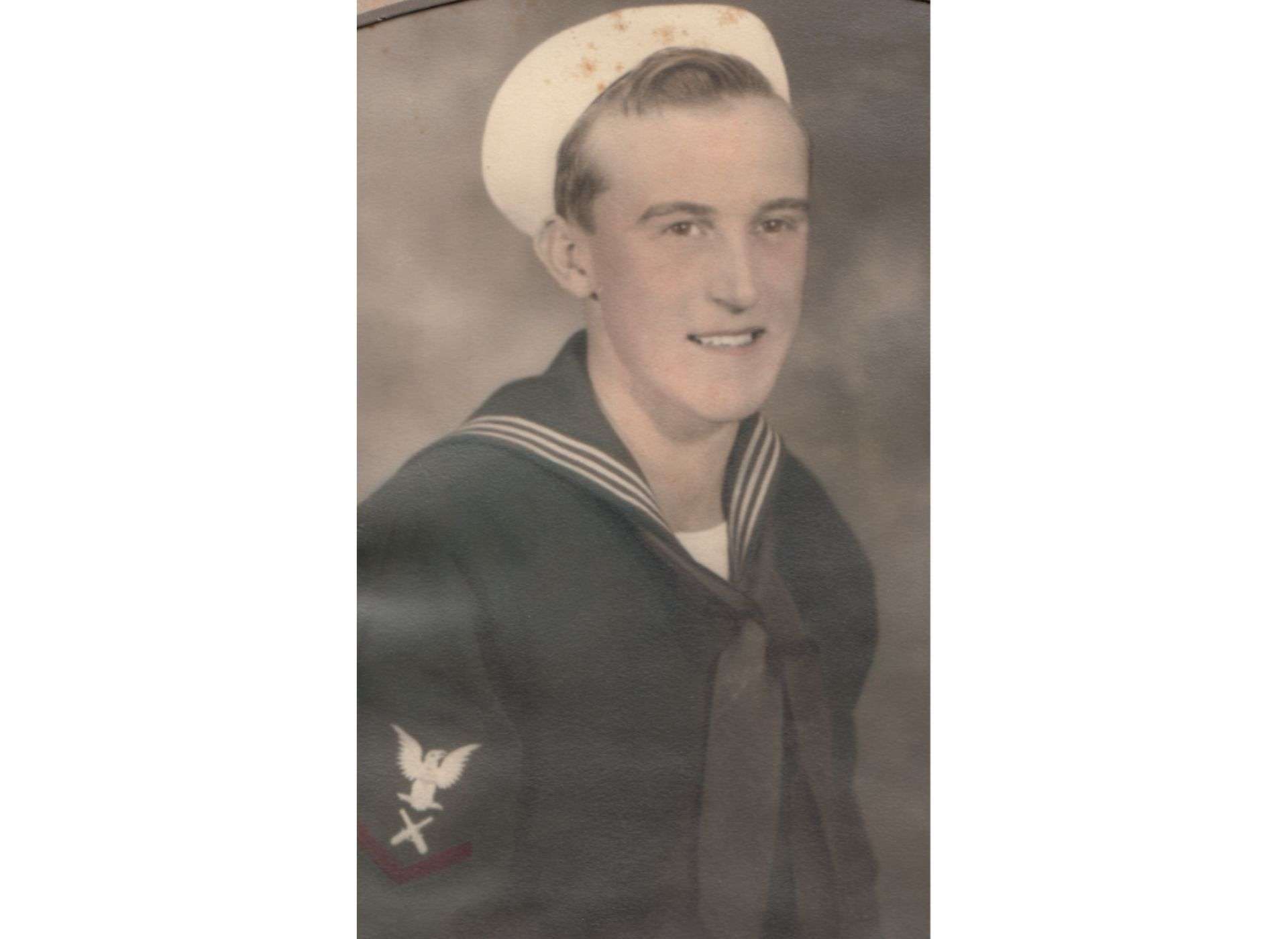
Seaman Second Class Donald Ross Naggatz (Berg) in his US Navy uniform. Gift In Memory of Donald Ross Naggatz, 2018.180.001
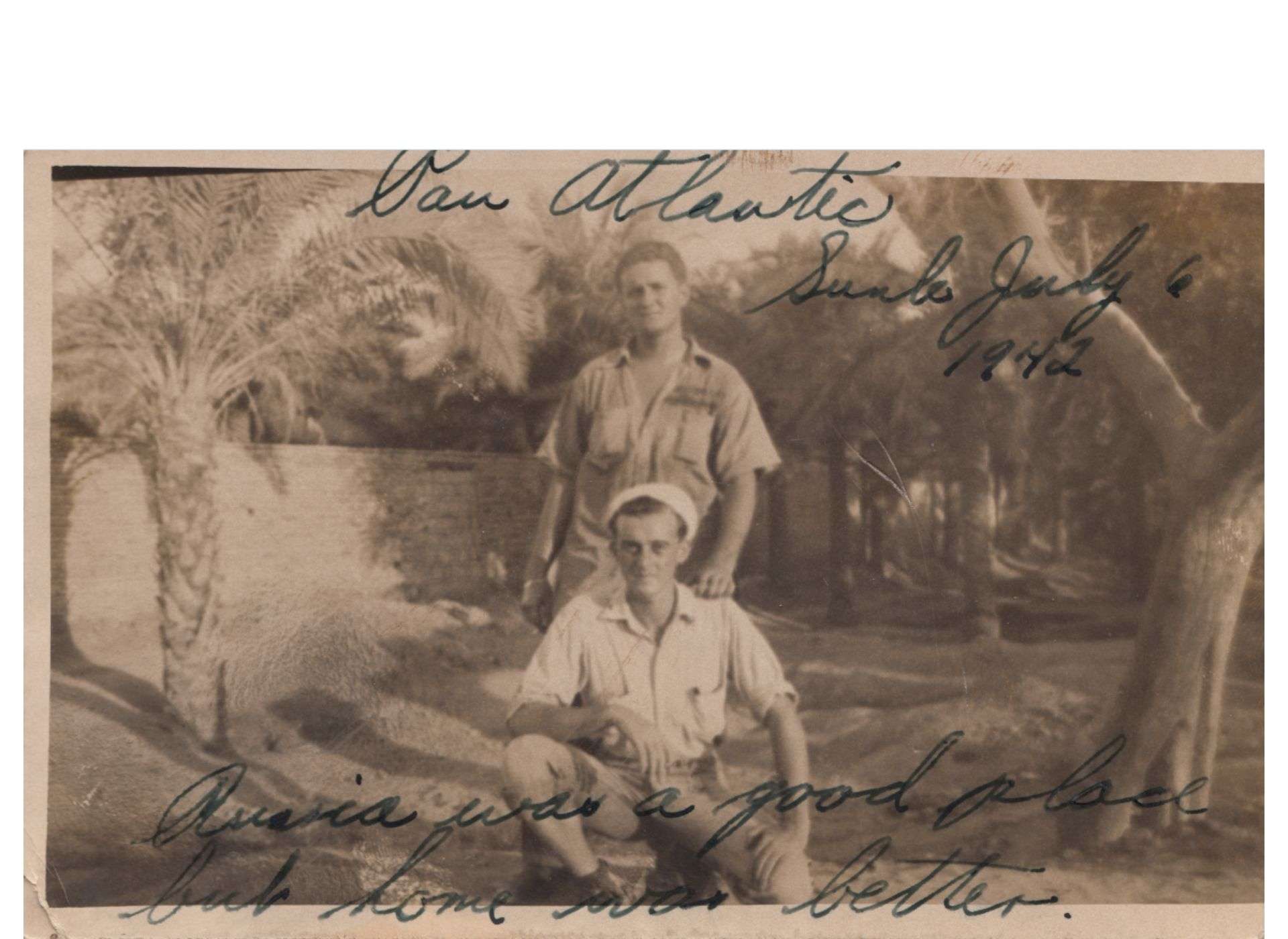
Photograph of Donald Ross Naggatz and an unidentified man. The writing on the picture reads: “Pan Atlantic Sunk July 6 1942 Russia was a good place but home was better.” Gift In Memory of Donald Ross Naggatz, 2018.180.002
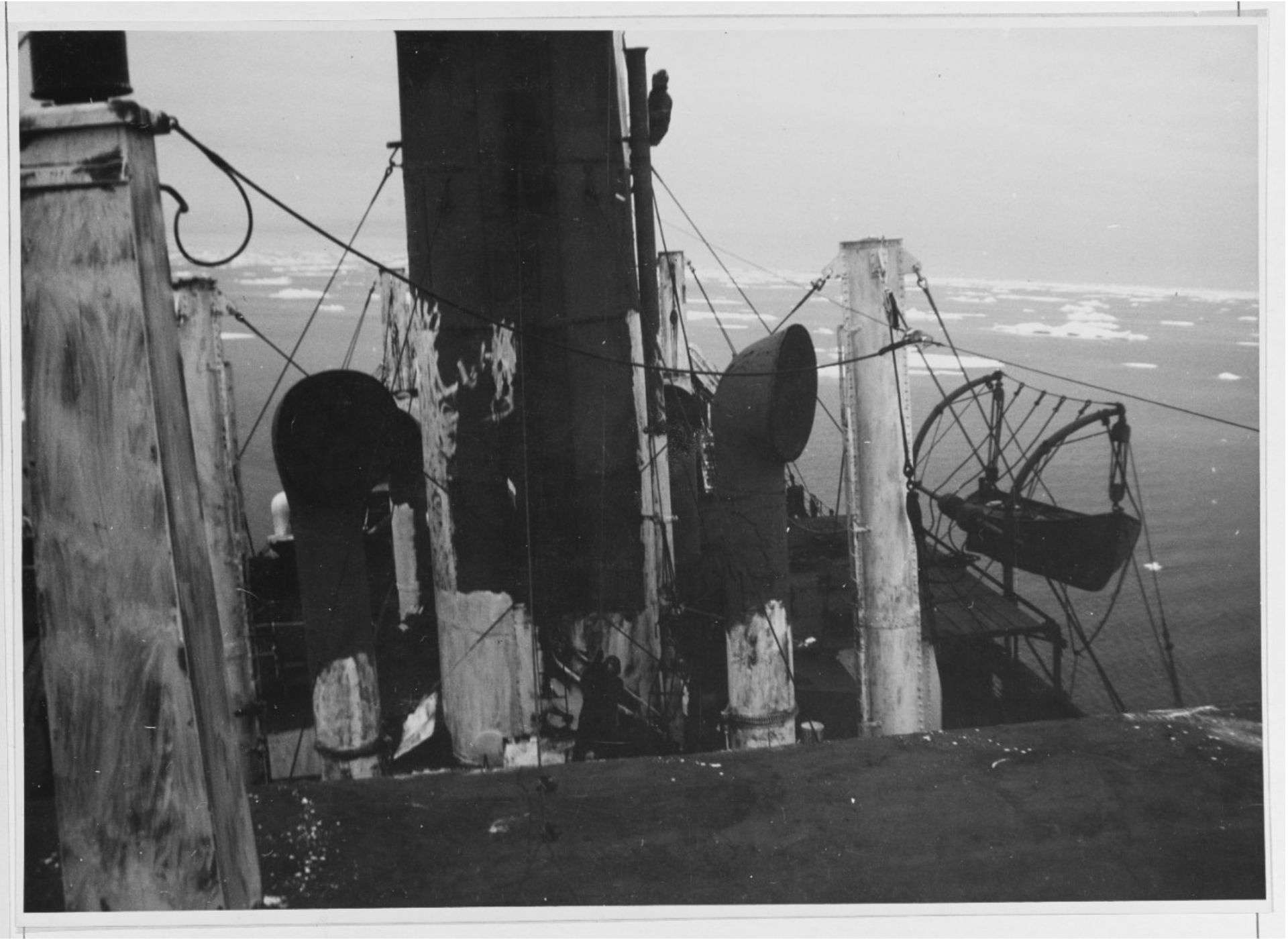
Crewmembers of SS Troubadour hurriedly camouflaging the ship with white paint to blend with Arctic ice during the passage of Convoy PQ-17 to Russia in July 1942. Courtesy Naval History and Heritage Command.
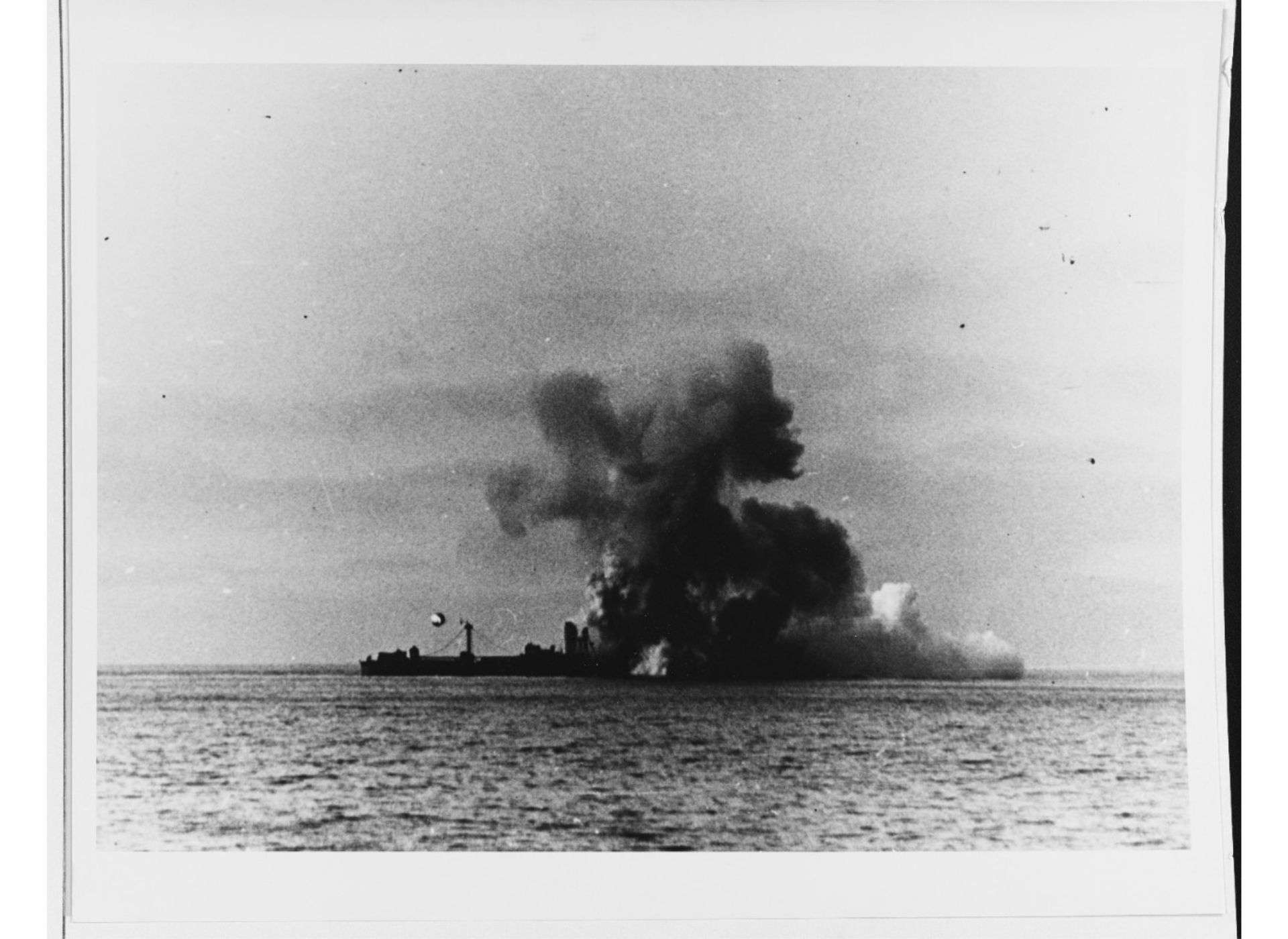
A merchant ship exploding after being struck by a torpedo. The photograph was taken by the attacking German U-boat. Courtesy Naval History and Heritage Command.
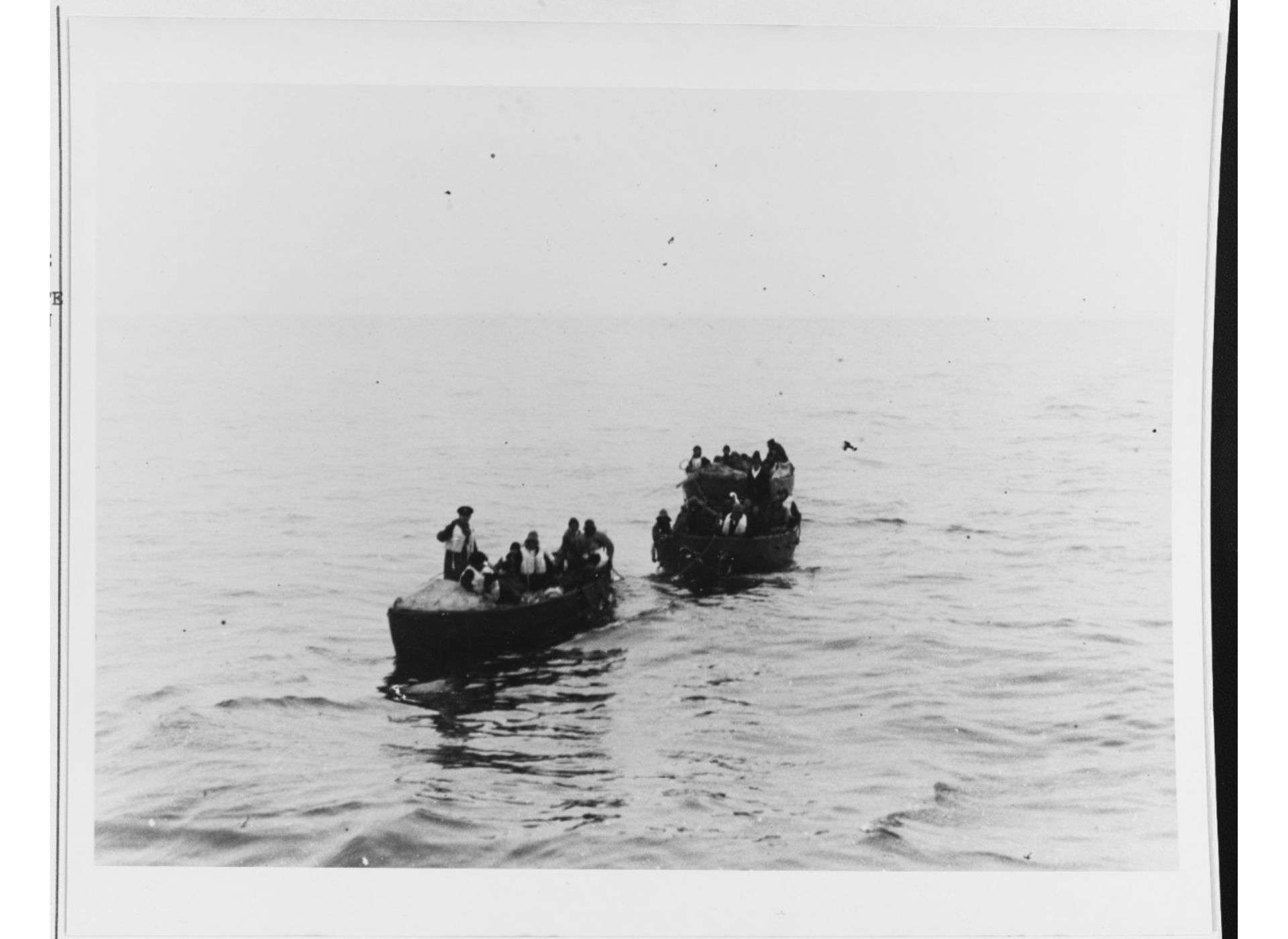
A German U-boat comes alongside lifeboats from the SS Carlton to interrogate her captain. The merchantman was torpedoed and sunk by a U-boat on July 5, 1942, during the battle of Convoy PQ-17. Courtesy Naval History and Heritage Command.
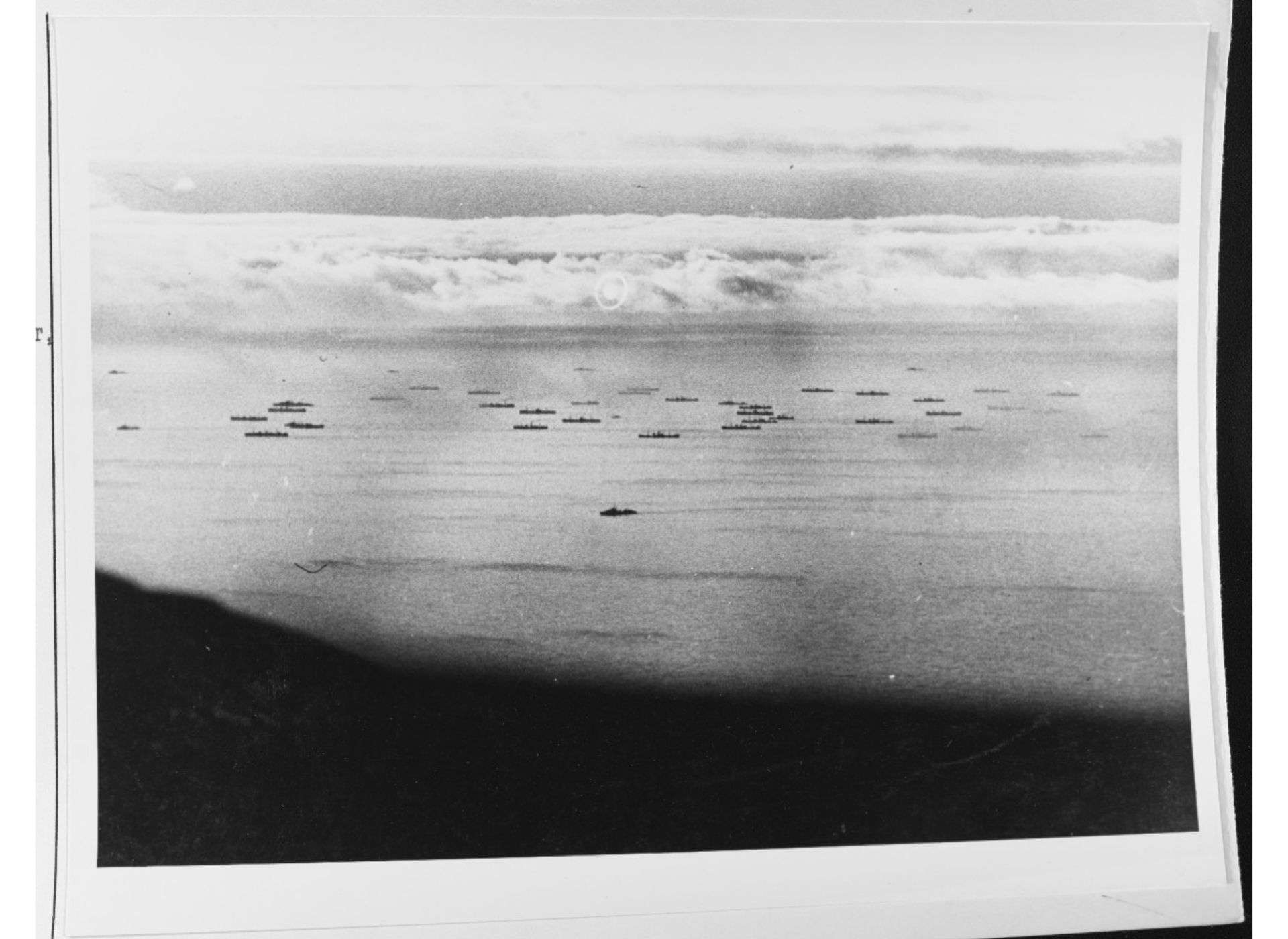
German aerial reconnaissance photo of PQ-17 underway at sea. The presence of a British cruiser, at left, indicates that the photo was taken before July 4, 1942, when the convoy was ordered to scatter. Courtesy Naval History and Heritage Command.
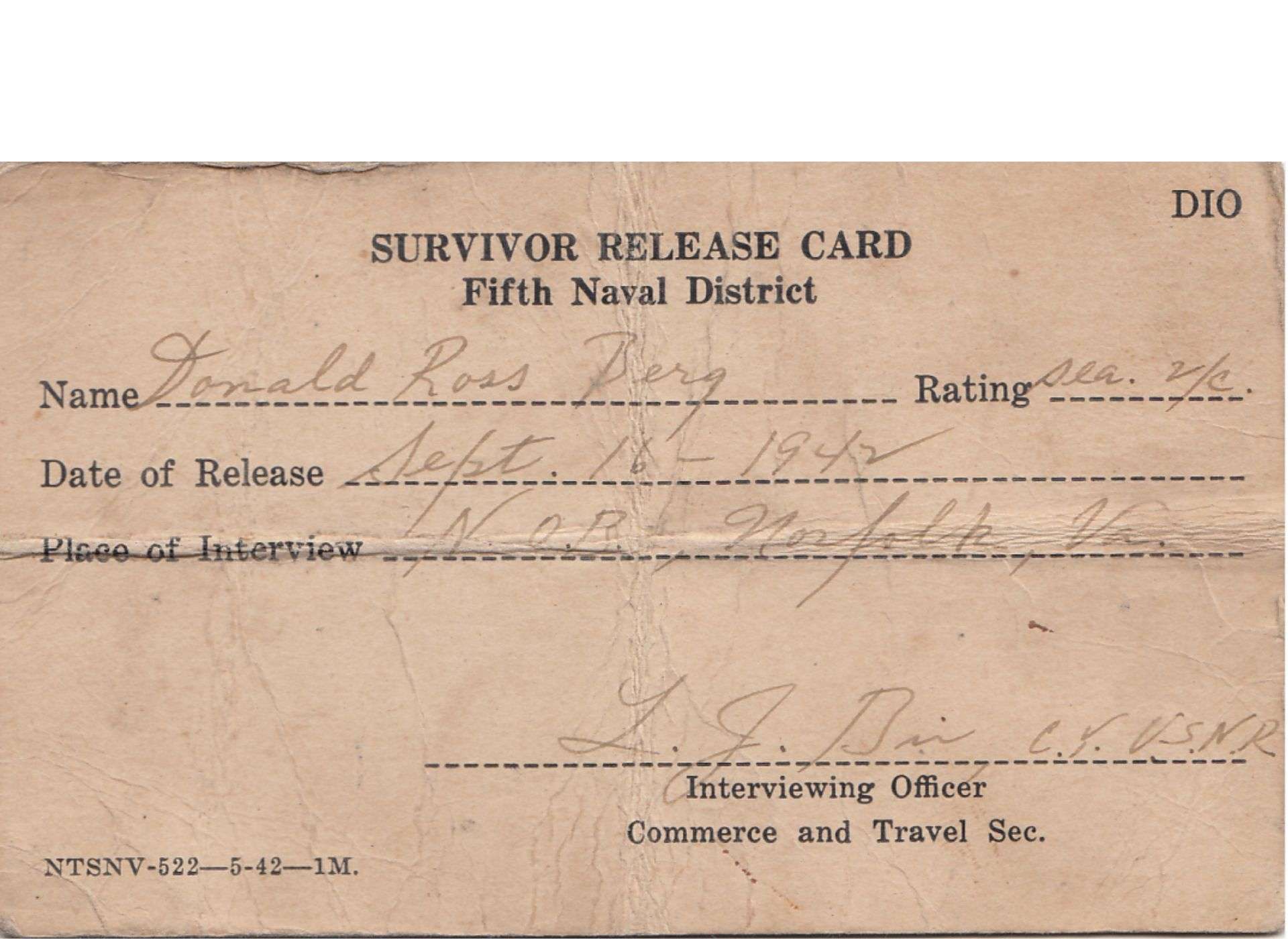
Survivor Release Card given to Naggatz after his return to the United States. Gift In Memory of Donald Ross Naggatz, 2018.180.003
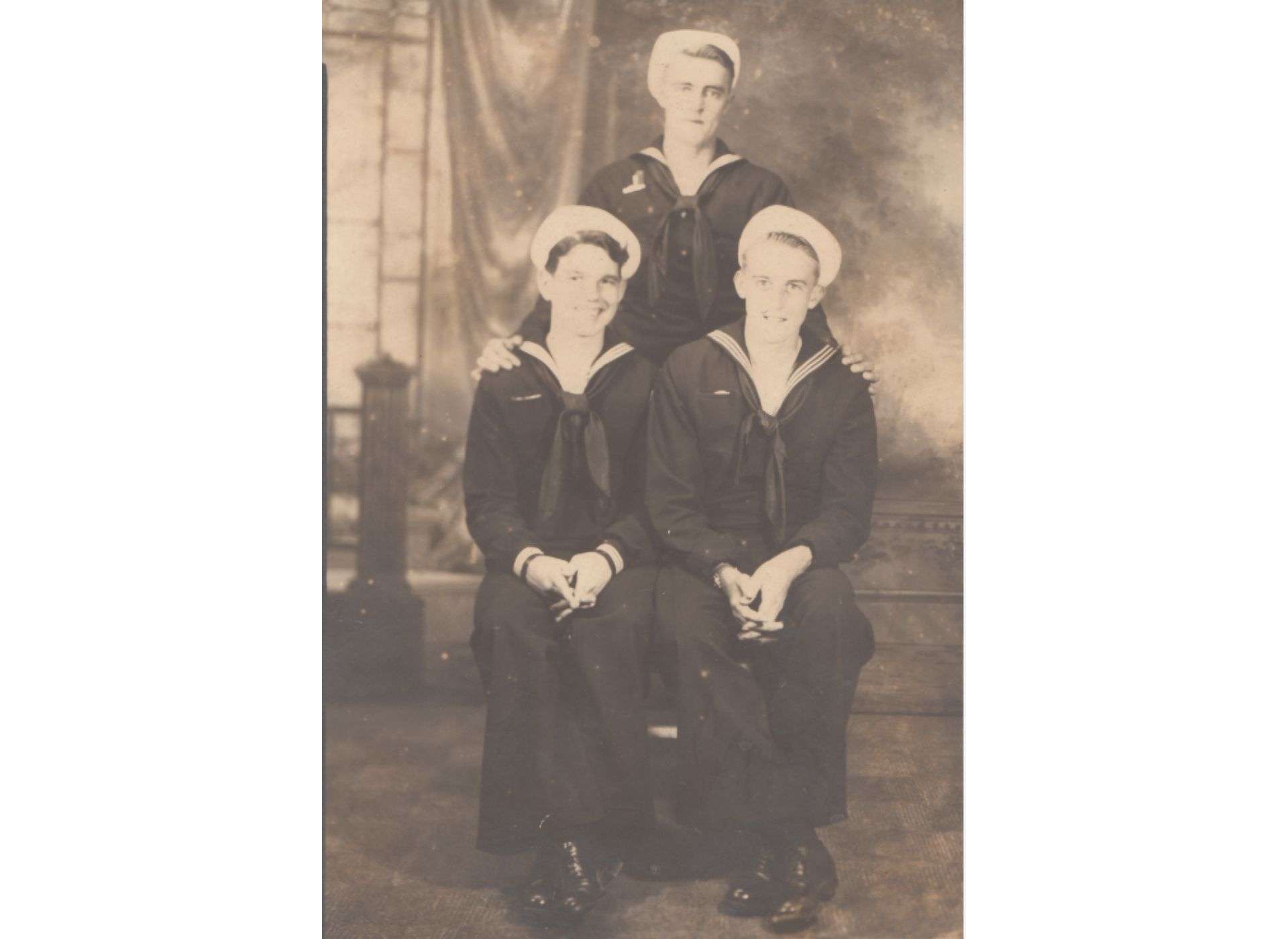
Photograph of Naggatz (bottom right) and two other surviving US Naval Armed Guardsmen from the SS Pan Atlantic, Moses L. Guthrie (standing center) and Dale L. Gosnell (left). Gift In Memory of Donald Ross Naggatz, 2018.180.004
“Convoy is to scatter.” These words sent chills down the spines of the men sailing in these merchant ships. While the thought was that scattering the convoy would make it harder for the Germans to sink the ships, what followed was the exact opposite and meant disaster for PQ-17. Without support from warships and left to fend for themselves, the merchant ships were sitting ducks for the German Kriegsmarine and Luftwaffe .
On July 5, 12 merchant ships were sunk by German attacks. Seaman Naggatz and the Pan Atlantic ’s luck ran out on July 6. The ship was valiantly trying to fight off German aerial attacks, but was hit by two bombs dropped by a Ju-88 bomber at 6:10 pm. The bombs set off the supply of cordite the ship was carrying, blowing apart the forward section of the vessel. The damage was so severe the ship sank in three minutes, preventing any distress signal from being sent.
Naggatz was manning a machine gun when the bombs hit and was thrown into the frigid sea. He clung to pieces of floating ice until he found a raft with a dead body on it. He was forced to push the body into the water for his own survival. After floating alone for a day, Naggatz was picked up by a lifeboat of his fellow survivors. The men spent three more days floating in the lifeboat until being rescued by the HMS Lotus . Out of a merchant marine crew of 37, 18 were killed. Seven of the 11 US Naval Armed Guard were lost as well. The survivors were taken to the Soviet Union for recuperation. Naggatz had to have his shoes and socks cut off because his hands and feet were so swollen.
While Naggatz would return to service and fight in the Pacific, many men and ships involved with PQ-17 would not. Out of a total of 35 ships in the convoy, only 11 reached Arkhangelsk. Matériel losses in the convoy were staggering as well: 3,350 vehicles, 210 aircraft, 430 tanks, and 99,316 tons of other cargo such as food and ammunition were lost. Adding insult to injury, the reports of the Tirpitz coming out to intercept the convoy were false. Winston Churchill called PQ-17 “one of the most melancholy naval episodes in the whole of the war.” The heavy losses of PQ-17 and the follow-up PQ-18 in September caused convoys to the Soviet Union to be suspended until December 1942.
The men of the US Merchant Marine and US Naval Armed Guard fought against long odds during the Battle of the Atlantic. Most of the large convoy battles fought during the war have been overshadowed by other important events such as D-Day or the Battle of the Bulge . But without the courage and sacrifice of men like Seaman Naggatz fighting to make sure the goods got through, the whole course of the war could have been very different and stretched on for many more years.
Top image: SS Pan Atlantic Passing under Railroad Bridge at Cape Cod Canal, 1938. Courtesy National Archives.
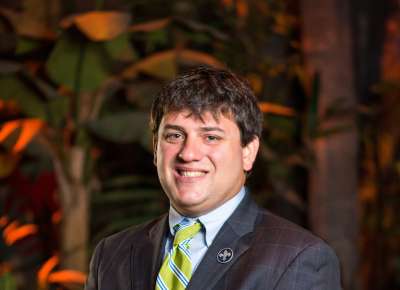
A New Orleans native, James Linn first became involved with the institution then known as The National D-Day Museum in 2001 as an eighth-grade volunteer on weekends and during the summer. Linn joined The National WWII Museum staff in 2014 and served as a Curator until 2020.
From the Collection
Explore further.
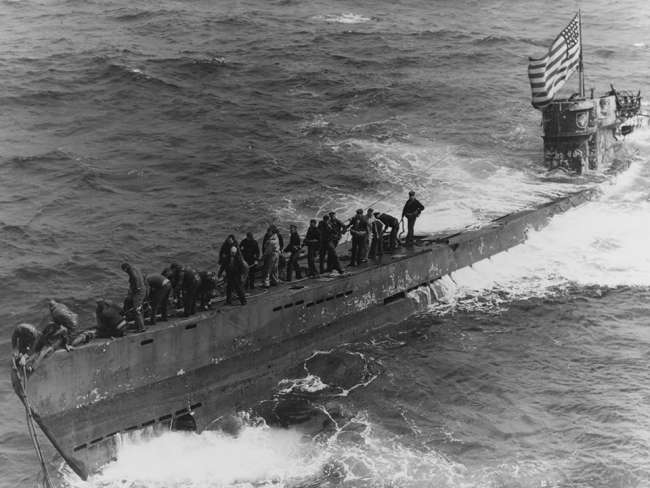
Wolf Beneath the Waves: U-505 Joins the Battle of the Atlantic
For Allied leaders, 1942 was a year of incredible danger and anxiety in the Battle of the Atlantic.

USS Mason : First in its Class
USS Mason was the first US Navy fleet vessel crewed by a majority of African American sailors.
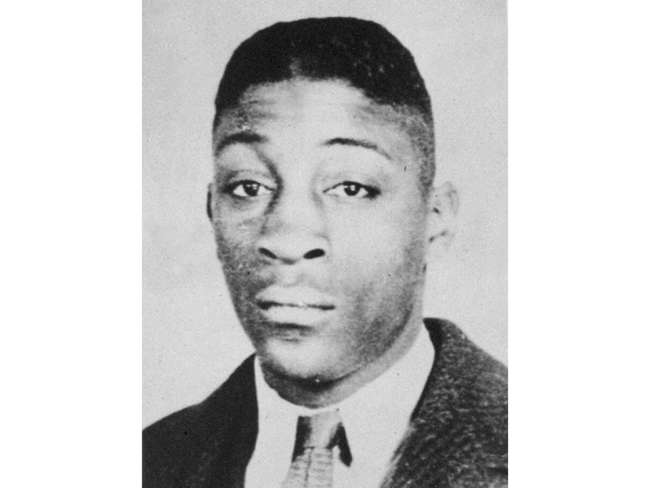
Sailor Charles Walter David Jr. Gave His Life to Save Fellow Americans
Coast Guardsman Charles Walter David Jr. volunteered to rescue sailors from the doomed USAT Dorchester and also saved the lives of two of his own shipmates.
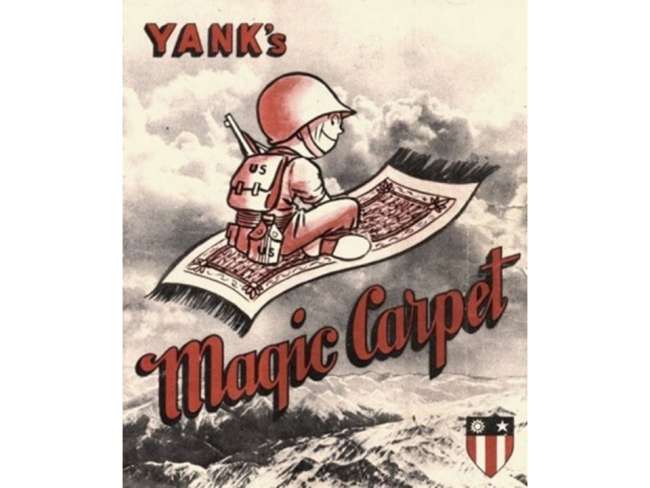
'Home Alive By ‘45’: Operation Magic Carpet
Though lasting only 360 days, Operation Magic Carpet was the largest combined air and sealift ever organized.
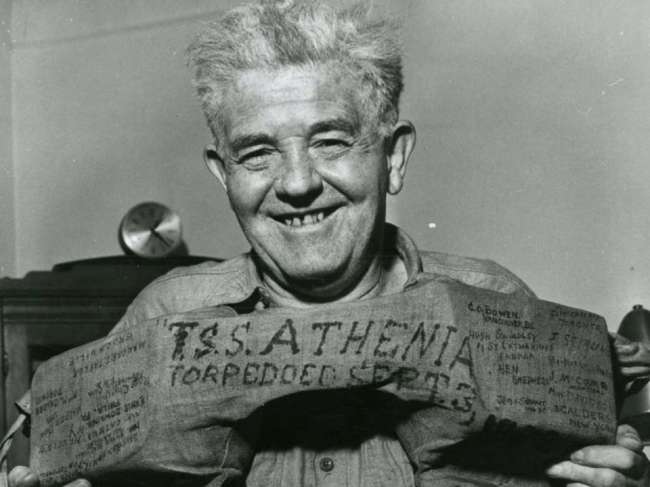
The Sinking of the SS Athenia
This is the story of Michael McShane and how he survived the sinking of the SS Athenia, the first ship torpedoed by a U-boat in World War II.
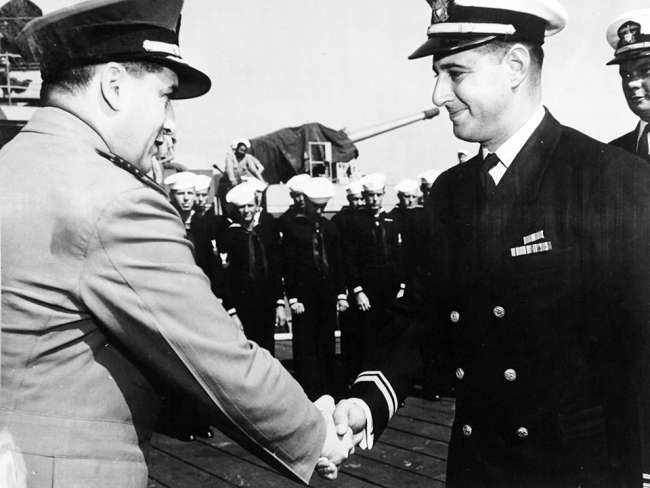
Forgotten Fights: USS Buckley Duels U-66
The Battle of the Atlantic was fought with some of the newest technologies, however, in one duel, creative sailors resorted to kitchenware in an effort to fend off boarding enemy sailors.
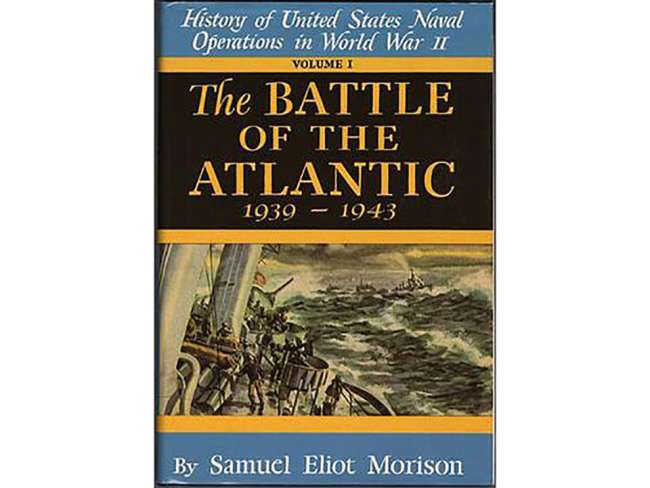
Inspired by True Events: A Greyhound Reading List
Portrayed in the new film Greyhound, starring Tom Hanks, the Battle of the Atlantic raged for almost six years. Here is a reading list to learn more about the epic battle to supply Allied forces in Europe.
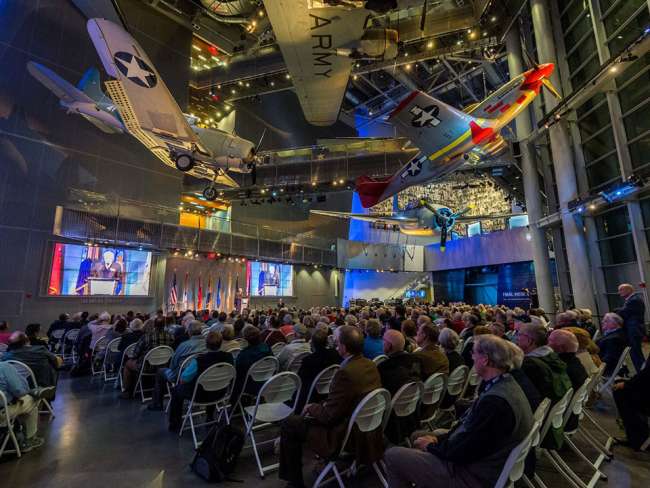
Best of WWII Public Programs: Hidden Gems
We look back at some of the best author events at The National WWII Museum.
Programs submenu
Regions submenu, topics submenu, poni 2024 capstone conference, dod's gaza pier and the maritime corridor—gaza: the human toll, lessons from myanmar.
- Abshire-Inamori Leadership Academy
- Aerospace Security Project
- Africa Program
- Americas Program
- Arleigh A. Burke Chair in Strategy
- Asia Maritime Transparency Initiative
- Asia Program
- Australia Chair
- Brzezinski Chair in Global Security and Geostrategy
- Brzezinski Institute on Geostrategy
- Chair in U.S.-India Policy Studies
- China Power Project
- Chinese Business and Economics
- Defending Democratic Institutions
- Defense-Industrial Initiatives Group
- Defense 360
- Defense Budget Analysis
- Diversity and Leadership in International Affairs Project
- Economics Program
- Emeritus Chair in Strategy
- Energy Security and Climate Change Program
- Europe, Russia, and Eurasia Program
- Freeman Chair in China Studies
- Futures Lab
- Geoeconomic Council of Advisers
- Global Food and Water Security Program
- Global Health Policy Center
- Hess Center for New Frontiers
- Human Rights Initiative
- Humanitarian Agenda
- Intelligence, National Security, and Technology Program
- International Security Program
- Japan Chair
- Kissinger Chair
- Korea Chair
- Langone Chair in American Leadership
- Middle East Program
- Missile Defense Project
- Project on Critical Minerals Security
- Project on Fragility and Mobility
- Project on Nuclear Issues
- Project on Prosperity and Development
- Project on Trade and Technology
- Renewing American Innovation Project
- Scholl Chair in International Business
- Smart Women, Smart Power
- Southeast Asia Program
- Stephenson Ocean Security Project
- Strategic Technologies Program
- Transnational Threats Project
- Wadhwani Center for AI and Advanced Technologies
- All Regions
- Australia, New Zealand & Pacific
- Middle East
- Russia and Eurasia
- American Innovation
- Civic Education
- Climate Change
- Cybersecurity
- Defense Budget and Acquisition
- Defense and Security
- Energy and Sustainability
- Food Security
- Gender and International Security
- Geopolitics
- Global Health
- Human Rights
- Humanitarian Assistance
- Intelligence
- International Development
- Maritime Issues and Oceans
- Missile Defense
- Nuclear Issues
- Transnational Threats
- Water Security
The Ice Curtain: Modernization on the Kola Peninsula

Table of Contents
Brief by Joseph S. Bermudez Jr. , Heather A. Conley, and Matthew Melino
Published March 23, 2020
Available Downloads
- Download the CSIS Brief 14916kb
CSIS Briefs
The Ice Curtain: Bringing Transparency to the Arctic is an ongoing collaborative series between the CSIS Europe Program and NGA.
The Kola Peninsula is the crux of Russia’s military establishment in the western Arctic, and its air and maritime capabilities are essential to Russia’s homeland defense, Arctic dominance, and global power projection capabilities. Russia’s modernization and expansion efforts at Severomorsk-1 air base, Gadzhiyevo submarine base, and Okolnaya submarine support base have significantly improved Russia’s operational readiness and its ability to control the surrounding maritime space in the Arctic. The Kola Peninsula is also home to systems such as the RS-24 YARS, located at the Plesetsk Cosmodrome, which pose a significant challenge to U.S. and allied defense systems. Russia’s willingness to use its arsenal of ballistic and cruise missiles to defend its position in the Arctic was on display during the Grom-2019 exercise. The expansion of Russia’s military presence in the Arctic is far from over—Russia will continue to deepen its military presence in the Arctic to protect Russian strategic interests well into the future.
INTRODUCTION
Russia’s western Arctic features a great concentration of advanced conventional capabilities for defensive and potentially offensive purposes centered on the Kola Peninsula and serves as home to Russia’s Northern Fleet headquarters, which hosts Russia’s most advanced Arctic land, air, and naval assets, notably including its nuclear arsenal and second-strike capabilities. The peninsula’s location—a gateway between the Arctic and the North Atlantic—and its extensive military assets make it central to Russia’s homeland defense and power projection capabilities. Russian military modernization efforts and new construction on the Kola Peninsula have centered around the refurbishment of air bases and expansion of naval bases. Severomorsk-1 air base, Gadzhiyevo submarine base, and Okolnaya submarine support base are particularly important because they expand and Russia’s defenses while ensuring Russia’s freedom of navigation and air sovereignty. Neighboring sites, such as the Plesetsk Cosmodrome, located at the Kura Missile Test Range in Arkhangelsk, enhance Russia’s Arctic military capabilities, as the recent Grom-2019 exercise demonstrated. The Plesetsk Cosmodrome is a particularly noteworthy site for testing advanced weapons such as the RS-24 Yars ICBM. Military exercises and weapons testing in and around the Kola Peninsula is frequent and reveals Russia’s operational readiness to engage its nuclear forces to deter adversaries in a potential conflict. Exercises such as Ocean Shield and Grom-2019 also demonstrate Russia’s calculation that the Arctic is a critical domain to its national security, power projection capabilities, and economic interests. Russia’s modernization and expansion efforts will likely continue on and around the Kola Peninsula well into the future, with the ultimate aim of asserting Russian sovereignty across the region.
MODERNIZATION OF SEVEROMORSK-1 AIR BASE
Located on the southern outskirts of Severomorsk and approximately 15.5 km northeast of Murmansk on the Kola Peninsula (Murmanskaya Oblast) is the Severomorsk-1 air base. Severomorsk-1 dates to World War II, when it was known simply as Severomorsk air base, protecting the Soviet Union’s northern flank and providing air protection for both navy facilities on the Kola Peninsula and Allied supply convoys destined for the port of Murmansk. 1 During the Cold War, Severomorsk-1’s strategic importance increased, along with that of its two sister air bases, Severomorsk-2 and Severomorsk-3. Strategic bomber (e.g., Tu-16/-95), strike (e.g., Su-24), and patrol aircraft (e.g., Il-38) based or staged at the bases were tasked with protecting the Soviet Union’s northwestern Arctic flank and providing strategic strike capability against the United States. With the collapse of the Soviet Union in 1991, the serviceability and capabilities of the Severomorsk air bases declined precipitously.
The strategic importance of Severomorsk-1 reemerged, however, during late 2011 or early 2012. During that time the Russian military began an extensive multi- year modernization project of the base in advance of the Russian Defense Ministry’s 2013 announcement that it was reengaging in the Arctic to guard its northern approaches, protect mineral and energy resources, and monitor shipping on the Northern Sea Route (NSR). 2 Since 2014, the air base has fallen under the command of the Northern Fleet. 3
Satellite imagery of Severomorsk-1 (69.030776 N, 33.42271 from May 14, 2012 shows that the base ceased to be operational as the modernization project was underway. Noticeable developments include:
- The concrete on the main runway and taxiways had been removed and the sub-surface was being graded.
- All operational aircraft had been moved to other air bases (likely Severomorsk-2 and -3).
- The remaining non-operational retired aircraft awaiting parts recovery and scrapping had been concentrated along the southwest side of the base in abandoned revetments, with 18 aircraft visible.
- The helicopter servicing and storage facility (also used for parts removal and scrapping) in the southwest corner remained operational, with at least 67 helicopters of several types and in various states of repair.
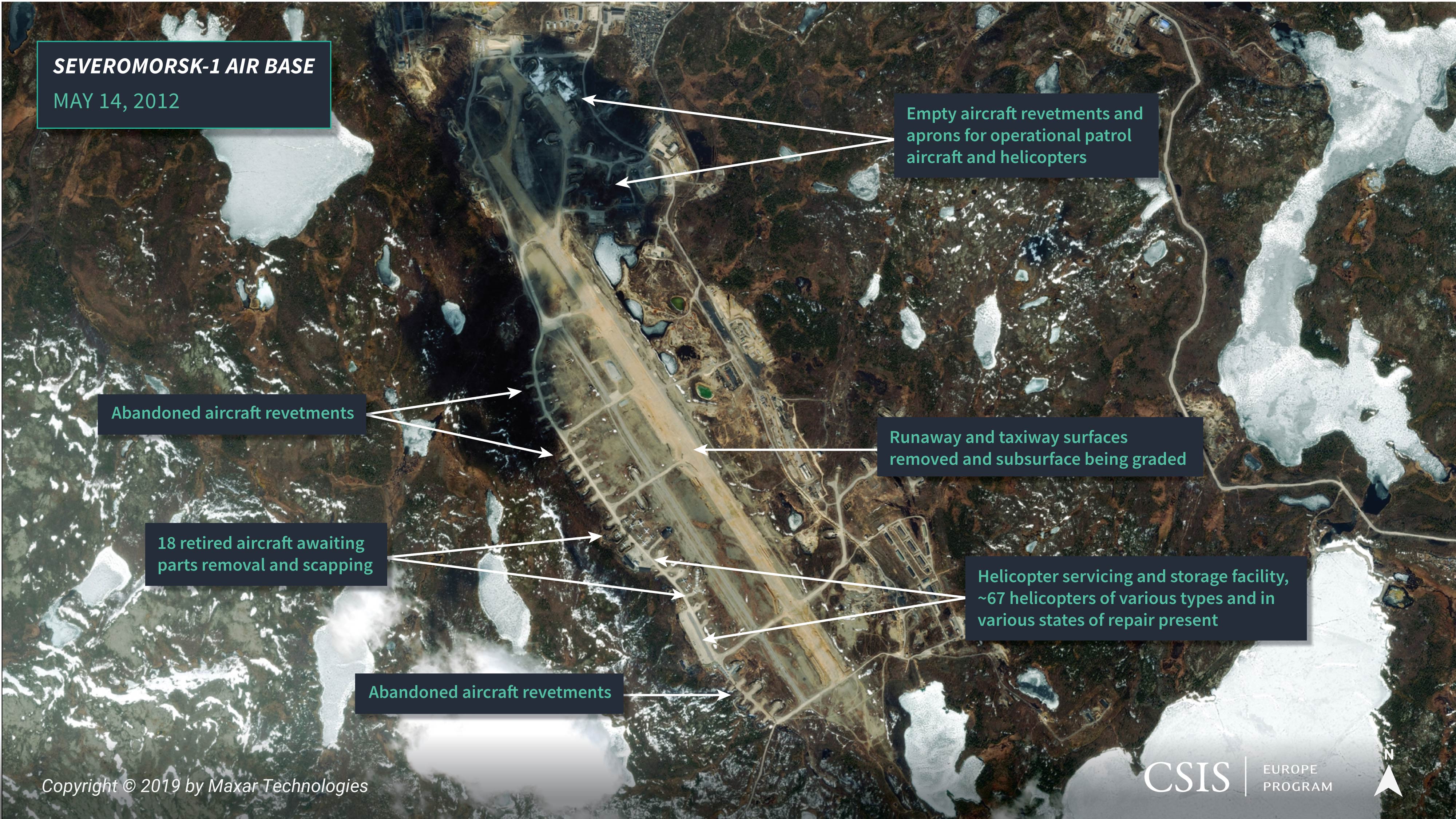
Five years later, on July 30, 2017, satellite imagery shows that considerable, albeit very slow, progress was made:
- While the base was still not operational, the paving of the 3,500-meter-long runway appeared to have been finished.
- Several new taxiways were under construction.
- The revetments and parking aprons for operational aircraft at the north end of the runway had been completed.
- The infrastructure for the instrument landing system (ILS) was under construction.
- The 18 retired aircraft awaiting parts recovery and scrapping that were previously in abandoned revetments on the southwest perimeter had been repositioned to an unimproved taxiway in the center of the air base.
- The number of helicopters at the helicopter servicing and storage facility declined to approximately 53 of several types and in various states of repair.
- Many of the previously abandoned aircraft revetments had been razed.
More recently, a September 4, 2019 satellite image shows that while the air base has once again become operational, the modernization project is not complete, as much of the work on parts of the infrastructure (e.g., completion of taxiways and aprons) remains to be completed. Among the indications that the base is operational include:
- Patrol and transport aircraft and helicopters were deployed on aprons and in revetments at the north end of the runway.
- A transport aircraft was present on the taxiway leading to the runway.
- Tire tracks from landings were visible on either end of the runway.
- The taxiways and aprons have continued to be slowly expanded.
- The number of helicopters at the helicopter servicing and storage facility have continued to decline, with approximately 36 of several types and in various states of repair being present.
- Only 12 of the approximately 18 retired aircraft awaiting parts recovery and scrapping remained. Several of which showed recent signs of being disassembled (e.g., wings sections laying on the ground).
Throughout this modernization, minor improvements have been undertaken among the air base’s supporting infrastructure, including housing, warehouses, machines shops, and support areas on the north side of the base.

However, the modern Murmansk-BN electronic warfare (EW) system, which had been reported as being deployed in the Severomorsk area, was not readily identified in the area immediately around Severomorsk-1 in the most recent satellite image. 4 Given the relatively slow pace of construction observed during the past seven years, it is unclear when the entire modernization project will finally be complete.
Upgrades to Severomorsk-1 increase Russian operational readiness, presence, and capabilities in the northwest Arctic region, particularly improving domain awareness and operational capacity around the Kola Peninsula. Increased numbers of patrol aircraft tasked for search-and-rescue operations improve the viability of the NSR as a maritime commercial route. With further upgrades to the base, operational capacity could expand further into the Barents Sea, Greenland Sea, North Atlantic, and an increasingly ice-free Arctic Ocean. In anticipation of receding ice and increased human activity in the Far North, Severomorsk-1 can deepen Russia’s strategic reach and propel its forward line of defense further from its coastline, enhancing anti- access/aerial denial capabilities near the Kola Peninsula. If the Murmansk-BN EW system is deployed (none of the satellite imagery currently shows the Murmansk-BN system), it would further bolster Russia’s Arctic capabilities by improving safety along the NSR and providing early- warning capabilities. With a reported range of 5,000- 8,000 km , Russia could theoretically monitor and disrupt communications across the entirety of the NSR and Scandinavia as well as deep into the Central Arctic Ocean. In May, the Northern Fleet reportedly completed its new Center for Radio-Electronic Warfare, which will oversee systems on Severomorsk. The Murmansk-BN and complimentary EW systems add another layer to Russia’s defense capabilities on the Kola Peninsula, potentially disabling foreign ships, submarines, or aircraft traveling toward the eastern entrance of the Russian Arctic. These EW assets would essentially render an intruder “ deaf, numb, and blind .” Russia’s EW capabilities were on display during NATO’s Trident Juncture 2018 exercise, when both Norway and Finland were the victims of Russian GPS jamming and interference, an increasingly important tool used frequently by Russia.
NEW MISSILE STORAGE FACILITY AT OKOLNAYA SUBMARINE SUPPORT BASE
The Okolnaya submarine support base (69.095773° 33.450602°) is located on the eastern shores of Guba Okolnaya (Okolnaya Bay), Murmanskaya Oblast, and serves as one of several strategically important Russian Navy submarine bases and submarine-launched ballistic missile (SLBM) storage and loading facilities on the Kola Peninsula. Other SLBM loading facilities include the Gadzhiyevo submarine base and Severodvinsk submarine base. 5 In addition to housing and maintaining SLBMs, Okolnaya likely stores nuclear warheads. While most often described as a submarine support base, it likely also supports the cruise missile requirements of other Northern Fleet surface combatants, such as the warships based across the bay at the Severomorsk navy base. The Okolnaya submarine support base has been associated with nuclear-armed SLBMs since the late-1950s. As a historical footnote, the base appears to have played a minor but important role during the 1962 Cuban Missile Crisis, when nuclear weapons may have been transported from Okolnaya to Cuba and back again during October-November 1962 by the merchant vessel Aleksandrovsk . The voyage of the Aleksandrovsk was unique in several ways: it was the only merchant vessel known to have carried missile-related equipment from Cuba to the Soviet Arctic, and it was one of the first to depart after the Soviet decision had been made to remove strategic weapons from Cuba. The vessel may have carried nuclear warheads to and from Cuba, perhaps without ever having offloaded them. By transferring nuclear warheads via this Arctic facility, the Soviets probably hoped to avoid any possible radiological monitoring or surveillance in either the Danish or Turkish Straits,” underscoring the importance of the Arctic as an avenue of approach to the United States. 6 During 2013, media reports indicated that the Okolnaya submarine support base would be expanded by the construction of a large storage facility for “. . . more than 100” RSM-56 Bulava SLBMs (NATO reporting name: SS-NX-30 or SS-N-32). The Bulava equips the Project 955/955A Dolgorukiy-class (also known as Borei-class) nuclear-powered ballistic missile submarines (SSBN), each of which can carry 16 missiles. The Dolgorukiy-class SSBNs are expected to eventually replace the Delta III- and Delta IV-class SSBNs currently in service with the Northern Fleet. 7 The location chosen for the new storage facility (69.114642° 33.525728°) is 3.7 km northeast of the main Okolnaya facilities on the site of an old open storage facility that consisted of 14 large revetments, several support buildings, and a large parking area. Satellite imagery shows that by May 2014 construction started and that by August 2015 there were a total of 31 weapons storage bunkers under construction (none of which were completed), with excavations underway on others. 8 By July 30, 2017, the number of bunkers completed or under construction rose to 38, and construction of what appears to be a triple fence security perimeter began. 9

Most recently, in satellite imagery from September 4, 2019, there are a total of 41 weapons storage bunkers (35 completed and 6 under construction) and excavations underway for at least 9 more. Additionally, there are several new small support buildings, and construction work on the triple fence security perimeter appears to slowly continue. Media reports indicate that construction of the facility is scheduled to be completed during 2020, and given the current rate of progress, and barring unforeseen circumstances, this projected date appears feasible. 10 All of the storage bunkers observed to date consist of an approximately 40-meter-by-32-meter concrete structure that is protected on three sides by earthen berms, with an approximately 52-meter-by-20-meter concrete pad on the fourth open side and a final 75-meter-by-18- meter protective berm in front of it. Thus, each storage bunker occupies a footprint of approximately 75-meters- by-90-meters. Internally, each bunker consists of fourapproximately 20-meter-by-32-meter storage bays. Adjacent to all the weapons storage bunkers is a smaller auxiliary bunker of varying sizes for unidentified purpose (potentially for power and environmental controls). It is assumed that when completed the facility will consist of a total of 50 storage bunkers, each with four storage bays, with the potential to house a total of 200 RSM-56 Bulava SLBMs, corroborating media reports from 2017. 11 While almost all media reports describe the new storage facility as being for nuclear-armed RSM-56 Bulava SLBMs, there is nothing to prevent sensitive non-nuclear munitions (e.g., cruise missiles) from also being stored. It is also likely that aside from ballistic and cruise missile support, the base provides other submarine-related support services. Likely in support of the larger role of the RSM-56 Bulava SLBMs stored at Okolnaya, and the slowly increasing number of Dolgorukiy-class SSBNs in the Northern Fleet, a second missile loading facility was built during 2012-2018. 12
NEW MISSILE STORAGE FACILITY AT GADZHIYEVO SUBMARINE BASE
The Gadzhiyevo submarine base (69.258878° 33.335251°) is located on the eastern shore of Guba Sayda (Sayda Bay), Murmanskaya Oblast, and serves as one of several strategically important Russian Navy submarine bases and SLBM storage and loading facilities on the Kola Peninsula. 13 It reportedly is the primary home port for the Northern Fleet’s Project 667BDRM Delfin (Delta IV) and Project 955/955A Dolgorukiy-class SSBNs. 14 As such, the base not only houses and maintains the R-29MU2 Liner (NATO reporting name: SS-N-23) SLBMs for the Delta IV and RSM-56 Bulava (NATO reporting name: SS-NX-30 or SS-N-32) SLBMs for the Project 955/955A Dolgorukiy-class SSBNs but also the nuclear warheads they support. The base may also support the cruise missile requirements of Northern Fleet surface combatants.
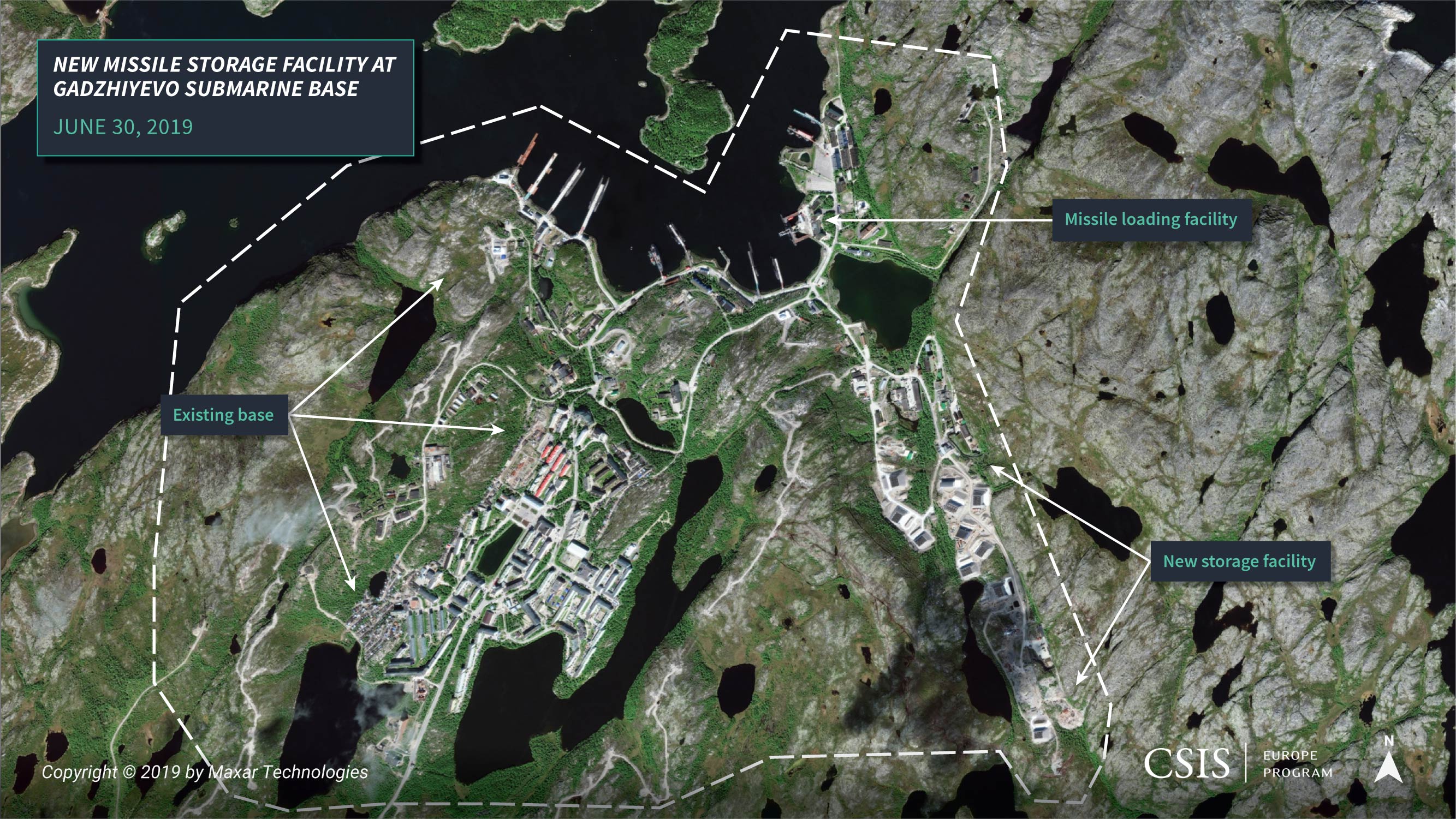
During 2013, media reports indicated that the Gadzhiyevo submarine base would expand to include the construction of a new SLBM storage facility. 15 The location chosen for the new storage facility (69.251165° 33.357418°) is one kilometer south of the main Gadzhiyevo facilities on the site of an existing storage facility. The existing facility consists of several vehicle maintenance and storage facilities and yards, bunkered storage facilities, open storage yards, and a number of support buildings. All but the bunkered storage facilities and open storage yards would be retained for the new facility. Satellite imagery shows that construction had started by May 29, 2014 and that there was a total of three weapons storage bunkers under construction, with excavations underway for others. By May 23, 2016, the number of bunkers under construction (none of which were completed at the time) rose to 10, and excavation work for a new support building began. Most recently, satellite imagery from June 30, 2019, shows that there is a total of 10 weapons storage bunkers with 5 completed and 5 under construction. Space within the existing storage facility remains for additional storage bunkers should the Russians decide to build them. Media reports suggest that construction of the facility is scheduled to be completed during 2020 to coincide with the launch of the eighth Dolgorukiy-class SSBN. 16 Given the current rate of progress, and barring unforeseen circumstances, this projected date appears feasible. All of the storage bunkers observed to date are similar to those built at the Okolnaya submarine support base and consist of an approximately 40-meter-by-32-meter concrete structure that is protected on three sides by protective berms, with an approximately 55-meter-by-20-meter concrete pad on the fourth open side and a final 65-meter- by-20-meter earthen berm in front of it. Thus, each storage bunker site occupies approximately a 90-meter- by-80-meter footprint. Internally, each bunker consists of four approximately 20-meter-by-32-meter storage bays. Adjacent to all the weapons storage bunkers is a smaller auxiliary bunker of varying sizes for unidentified purposes (potentially for power and environmental controls). At present, there are a total of 10 storage bunkers, each with four storage bays, which would imply that the facility has the potential to house a total of 40 RSM-56 Bulava or R-29MU2 Liner SLBMs, although most reports state that they will be used for the nuclear-armed RSM-56 Bulava. Regardless, there is nothing to prevent sensitive or non-nuclear munitions (e.g., cruise missiles) from also being stored here. Unlike the Okolnaya submarine support base, no second missile loading facility has yet to be built at the Gadzhiyevo submarine base.
Russia’s 2017 updated Naval strategy elevated the role of its maritime forces in securing Russia’s Arctic domain. The strategy builds on President Putin’s promise in 2010 to spend more than 20 trillion rubles to modernize 70 percent of all Russian military equipment by 2020. Under this modernization plan, Russia’s naval forces are a priority, harkening back to the Cold War when Soviet maritime capabilities posed a formidable challenge to NATO. Upgrades at Gadzhiyevo and Okolnaya reinforce defensive and offensive capabilities around the Kola Peninsula. Naval bases housing Delta IV-class and Dolgorukiy-class SSBNs are a key component of Russia’s bastion defense concept. These SSBNs, when equipped with SLBMs, are the backbone of Russia’s sea-based component of its nuclear triad. Importantly, the SSBNs represent Russia’s second- strike capabilities and serve as a deterrent against potential adversaries. The Dolgorukiy-class in particular boasts improved stealth capabilities as well as increased SLBM payload, adding to Russia’s “ defense in depth ” of the Kola Peninsula. Stealthier submarines such as these enhance the regime’s survivability and pose a challenge to NATO’s sea lines of communication in the North Atlantic as NATO is increasing its anti-submarine warfare capabilities. While the primary objective of the SSBNs is defensive, they also serve as a tool of power projection beyond the Kola Peninsula. Admiral James Foggo, commander of Allied Joint Force Command Naples, warned about Russia’s renewed capabilities in the North Atlantic and the Arctic. Of particular concern is the ability of Russian submarines to project power through the Greenland-Iceland-United Kingdom (GIUK) Gap. In October 2019, NATO tracked 10 Russian submarines south of Iceland testing their stealth abilities and demonstrating their capacity to threaten the strategic maritime route between the United States and Northern Europe. The exercise also exposed Russia’s ability to break out into the North Atlantic and threaten the east coast of the United States. Russia’s defense of its western Arctic territory is determined by its ability to control the surrounding maritime space and assert its presence in maritime choke points like the Greenland-Iceland-United Kingdom-Norway (GIUK-N) Gap. To this end, Gadzhiyevo and Okolnaya are critical staging grounds and house Russia’s most advanced capabilities.
PLESETSK COSMODROME: TESTING RS-24 YARS ICBMS DURING GROM-2019
Between October 15-17, 2019 Russia held its annual Grom (Thunder) strategic nuclear forces exercise (Grom-2019). Among the elements that participated in the exercise were units from the Strategic Rocket Forces, Long-Range Aviation, Military Transport Aviation, and Russian Navy. Included within the exercise was the launch of a road-mobile RS-24 Yars (NATO reporting name: SS-29 or SS-27) ICBM from the Plesetsk Cosmodrome, in Mirny, Arkhangelsk Oblast, at the Kura Missile Test Range, originally known as Kama, in Kamchatskiy Kray (eastern Russia). 17

On October 3, 2019, just 12 days before the start of the Grom-2019 exercise, a satellite image was collected of the Plesetsk Cosmodrome. This image covered what is reported to be “Launch Complex 158” (63.008134° 41.551304°), 52 km east of the main facility. 18 The complex encompasses approximately 148,350 square meters and is surrounded by a security fence. The site’s launch pads, single-bay garage, and support buildings occupy a T-shaped area lying on a generally east-west axis. The maximum east-west width is 365 meters and maximum north-south height is 240 meters. Visible in the October 3, 2019 image of Launch Complex 158 are two RS-24 Yars ICBMs resting on their MZKT- 79221 16x16 Transporter-Erector-Launchers (TEL). These TELs are positioned, one apiece, on the complex’s east and west launch pads. Also visible are several support vehicles on the east launch pad and additional support vehicles in the complex’s parking area. From ground imagery released by the Russian Defense Ministry, the TEL at the western launch is the one that subsequently conducted the training launch during the exercise. 19 The TEL at the east launch pad was likely present as a backup in case of mechanical issues. It is unknown from which of the five reported rocket divisions these two RS-24 systems came from.
The RS-24 YARS is an ICBM capable of carrying multiple thermonuclear warheads. It has an estimated range of 10,500 km , allowing Russia to escalate a regional conflict to a global context. The system is a cornerstone of Russia’s land-based nuclear deterrent, and its road-mobile delivery system increases its survivability. Other factors, including the missile’s ability to maneuver during flight, deploy active and passive decoys, and its reported seven minute launch time, pose significant challenges to U.S. and allied missile defense systems. Russia exercised both its strategic and tactical nuclear forces during Grom-2019. The exercise included naval assets from all four Russian fleets, showing the extent to which Russia will mobilize across its military districts to defend its Arctic interests. As other analysts have noted , Grom highlighted Russia’s willingness to defend its Arctic territory with a growing arsenal of ballistic and cruise missiles. It also demonstrated the extent to which Russia has already integrated intermediate-range and shorter-range missiles in its nuclear strategy in light of the uncertain future of arms control. 20 Grom also offers insight into Russia’s evolving nuclear doctrine. Major General Evgeny Ilyin described the exercise as one where the preservation of borders and the sovereignty and territorial integrity of the Russian Federation is threatened, thus warranting the use of nuclear weapons. President Putin noted in October 2018 that Russia would only use nuclear weapons when the country is “under attack.”
The Kola Peninsula is the centerpiece of Russia’s military establishment in the western Arctic, and its air and maritime capabilities are essential to homeland defense, Arctic dominance, and global power projection capabilities. The concentration and range of multi-domain assets— from SLBMs and ICBMs to EW—deployed on and around the Peninsula underscores the Arctic’s strategic value to Russian national interests. As Arctic nations increase their capabilities in a more accessible Arctic and as non- Arctic nations such as China seek greater access to the Arctic, we can expect Russia’s military presence to expand to include conventional and dual-use assets. As the head of the Northern Fleet noted on December 8, “In the near future, we should expect a further increase in the military presence of the combined armed forces and, as a result, an increase in the likelihood of conflict.” Although Admiral Moiseev was referring to NATO as well as Sweden and Finland, his comment could easily refer to Russia’s military presence in the Arctic. Matthew Melino was an associate fellow with the Europe Program at the Center for Strategic and International Studies (CSIS) in Washington, D.C. Heather A. Conley is senior vice president for Europe, Eurasia, and the Arctic and director of the CSIS Europe Program. Joseph S. Bermudez Jr. is senior fellow for Imagery Analysis at CSIS. This brief is made possible by general support to CSIS. No direct sponsorship contributed to this brief.
The Center for Strategic and International Studies' Europe Program and the National Geospatial-Intelligence Agency partnership uses unclassified geospatial imagery and data to produce new, timely, and accurate reporting on Arctic construction and modernization of civilian, dual-use, and defensive infrastructure. For more info, read the Tearline Program Explainer . To read more, visit NGA’s Tearline article or download the Tearline app from the Apple Store or Google Play . This content also syndicates to the Office of the Director of National Intelligence’s website intelligence.gov , which is a transparency effort to better explain certain strategic, economic, and humanitarian IC missions to the public.
CSIS Briefs are produced by the Center for Strategic and International Studies (CSIS), a private, tax-exempt institution focusing on international public policy issues. Its research is nonpartisan and nonproprietary. CSIS does not take specific policy positions. Accordingly, all views, positions, and conclusions expressed in this publication should be understood to be solely those of the author(s). © 2020 by the Center for Strategic and International Studies. All rights reserved. Please consult the PDF for references.

Joseph S. Bermudez Jr.
Heather a. conley, matthew melino, programs & projects.

IMAGES
VIDEO
COMMENTS
Learn about the final voyage of the famous explorer to the New World in 1502, when he faced storms, storms, and native cultures. Find out how he discovered parts of Central America, met the Mayans, and died on Jamaica.
Summarize This Article The fourth voyage and final years of Christopher Columbus. The winter and spring of 1501-02 were exceedingly busy. The four chosen ships were bought, fitted, and crewed, and some 20 of Columbus's extant letters and memoranda were written then, many in exculpation of Bobadilla's charges, others pressing even harder the nearness of the Earthly Paradise and the need ...
The fourth voyage of Columbus was a Spanish maritime expedition in 1502-1504 to the western Caribbean Sea led by Christopher Columbus. The voyage, Columbus's last, failed to find a western maritime route to the Far East, returned relatively little profit, and resulted in the loss of many crew men, all the fleet's ships, and a year-long ...
Fourth voyage (1502-1504) Columbus's fourth voyage. After much persuasion, the sovereigns agreed to fund Columbus's fourth voyage. It would be his final chance to prove himself and become the first man ever to circumnavigate the world. Columbus's goal was to find the Strait of ...
The fourth voyage that Christopher Columbus undertook to the New World was also his final one. He left Spain on May 11th, 1502 with four ships, and went in search of the Strait of Malacca to the Indian Ocean. This was due to his false belief that in his three previous voyages to the New World he had actually arrived on the coast of Asia.
A Significant Fourth Trip. Despite the fact that Columbus had been brought back to Spain in chains, he was still able to make one more voyage to the New World. Upon news of Columbus's arrest, the royal couple promptly freed and eventually allowed the adventurer to participate in a fourth voyage to the New World.
Christopher Columbus made a fourth voyage, nominally in search of the Strait of Malacca to the Indian Ocean. On May 11, 1502, four old ships and 140 men under Columbus's command put to sea from the port of Cadiz. Among those accompanying him were his brother Bartholomew, and younger son Fernando, then thirteen years old.
Christopher Columbus (born between August 26 and October 31?, 1451, Genoa [Italy]—died May 20, 1506, Valladolid, Spain) was a master navigator and admiral whose four transatlantic voyages (1492-93, 1493-96, 1498-1500, and 1502-04) opened the way for European exploration, exploitation, and colonization of the Americas. He has long been called the "discoverer" of the New World ...
The explorer Christopher Columbus made four voyages across the Atlantic Ocean from Spain: in 1492, 1493, 1498 and 1502. His most famous was his first voyage, commanding the ships the Nina, the ...
The fourth voyage of Columbus was a Spanish maritime expedition in 1502-1504 to the western Caribbean Sea lead by Christopher Columbus. The voyage, Columbus's last, failed to find a western maritime route to the Far East, returned relatively little profit, and resulted in the loss of many crew men, all the fleet's ships, and a year-long marooning in Jamaica.
The Fourth Voyage of Columbus. Columbus persuaded the Spanish monarchs to sponsor one last voyage to the New World. The objective of this journey was to locate the passage to Asia that no one had discovered yet, but which Columbus firmly believed existed. Accompanied by his brother and son, Columbus departed Spain on May 11th.
This simple lesson ignores the broader story of Christopher Columbus's four voyages to the New World and the impact those explorations had on Europe and the Americas. Columbus's last voyage left Europe on May 11, 1502, and continued his quest for a sea route to China, this time by exploring the coastal areas west of the Caribbean islands.
The Fourth Voyage of Columbus. If any of Columbus's voyages deserves to be made into a movie, this is the one. On May 11, 1502, four old ships and 140 men under Columbus's command put to sea from the port of Cadiz. Among those in the fleet were Columbus's brother Bartholomew, and Columbus's younger son Fernando, then just thirteen years old.
Christopher Columbus (/ k ə ˈ l ʌ m b ə s /; between 25 August and 31 October 1451 - 20 May 1506) was an Italian explorer and navigator from the Republic of Genoa who completed four Spanish-based voyages across the Atlantic Ocean sponsored by the Catholic Monarchs, opening the way for the widespread European exploration and European colonization of the Americas.
Second Voyage, 1493-1496. In early May 1493, Columbus responded to their request in a letter (AJ-064) outlining his plans for colonizing the Caribbean. He left on September 25, 1493, in a fleet of seventeen ships with about 1,200 colonists. Among these were the Queen's physician, Dr. Diego Alvarez Chanca, his younger brother Diego, Juan de la ...
Columbus, Letter from the Fourth Voyage. An Electronic Edition · Christopher Columbus (1451-1506) Original Source: The Voyages of Christopher Columbus, Being the Journals of his First and Third, and the Letters Concerning his First and Last Voyages, to Which is Added the Account of his Second Voyage Written by Andres Bernaldez.
In October 1501 Columbus went to Sevilla to make ready his fourth and final expedition. Christopher Columbus - Exploration, Caribbean, Americas: The gold, parrots, spices, and human captives Columbus displayed for his sovereigns at Barcelona convinced all of the need for a rapid second voyage. Columbus was now at the height of his popularity ...
The Fourth Voyage of Christopher Columbus (1502) The first likely contact between the Spanish and Maya (or their neighbors in Honduras to the east) occurred in the 1502 voyage of Christopher Columbus between Hispaniola and the Darién peninsula of Panama. During a brief stopover at Bonacca (then called Guanaja) in the Bay Islands on the ...
After his famous 1492 voyage of discovery, Christopher Columbus was commissioned to return a second time, which he did with a large-scale colonization effort which departed from Spain in 1493. Although the second journey had many problems, it was considered successful because a settlement was founded: it would eventually become Santo Domingo, capital of the present-day Dominican Republic.
My 2123 of the 4th. Convoy is to scatter. - British Admiralty to commanders of Convoy PQ-17, July 4, 1942. With just these few words, the fate of the Soviet Union bound Convoy PQ-17 was sealed and the story of Seaman Second Class Donald Ross Naggatz (Berg) begins. Naggatz was born in Hastings, Nebraska, but was raised in North Dakota.
Murmansk, seaport and center of Murmansk oblast (region), northwestern Russia, lying 125 miles (200 km) north of the Arctic Circle, and on the eastern shore of Kola Bay, 30 miles (48 km) from the ice-free Barents Sea.The town, founded in 1915 as a supply port in World War I, was a base for the British, French, and American expeditionary forces against the Bolsheviks in 1918.
Central part of Murmansk. Murmansk (Russian: Мурманск; Kildin Sami: Мурман ланнҍ; Skolt Sami: Muurman and Northern Sami: Murmánska) is a port city and the administrative center of Murmansk Oblast in the far northwest part of Russia.It sits on both slopes and banks of a modest ria or fjord, Kola Bay, an estuarine inlet of the Barents Sea, with its bulk on the east bank of ...
MODERNIZATION OF SEVEROMORSK-1 AIR BASE. Located on the southern outskirts of Severomorsk and approximately 15.5 km northeast of Murmansk on the Kola Peninsula (Murmanskaya Oblast) is the Severomorsk-1 air base. Severomorsk-1 dates to World War II, when it was known simply as Severomorsk air base, protecting the Soviet Union's northern flank ...